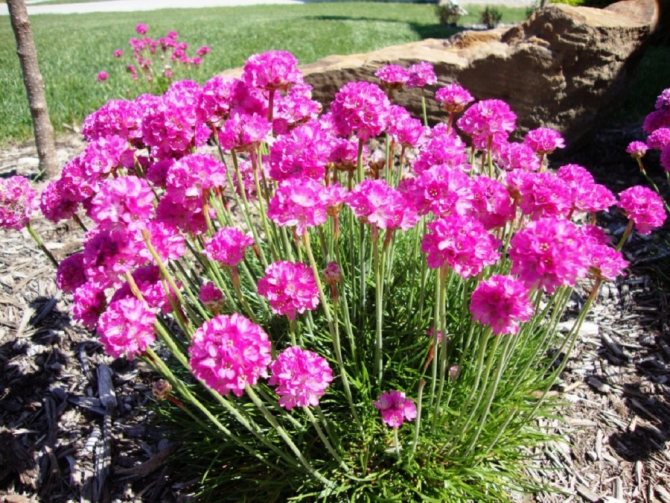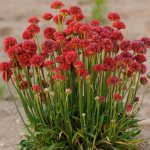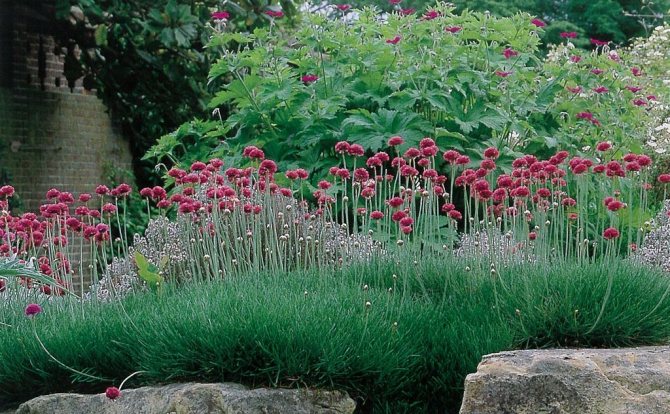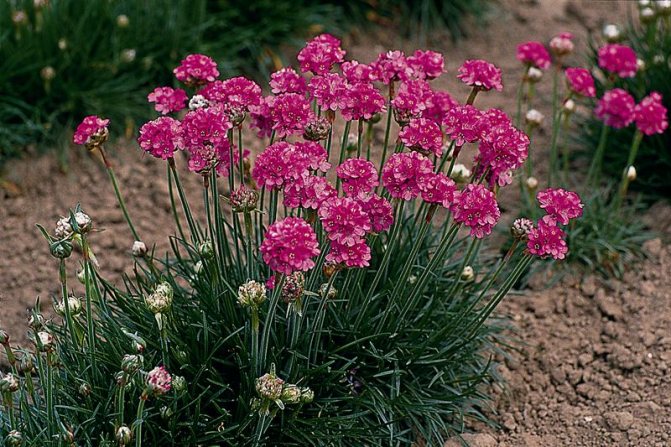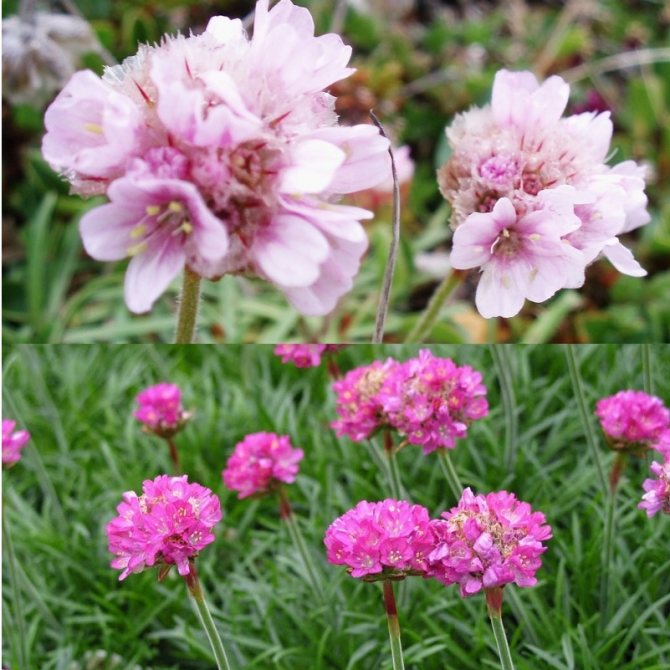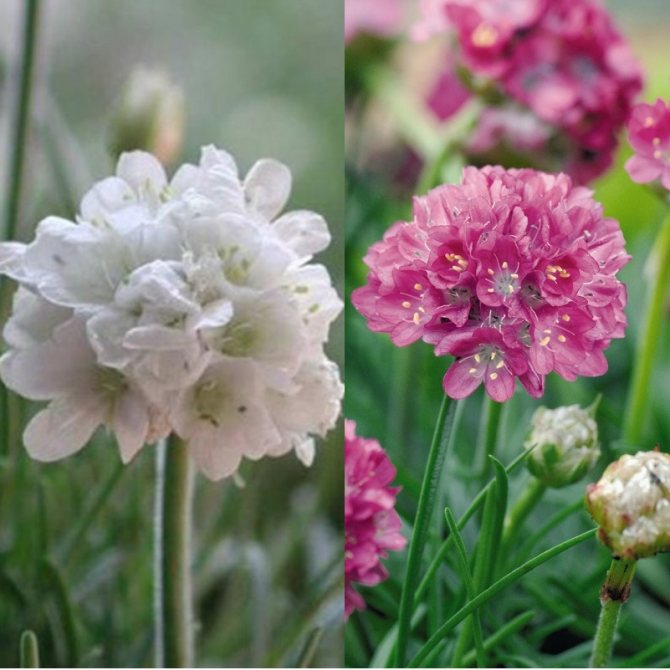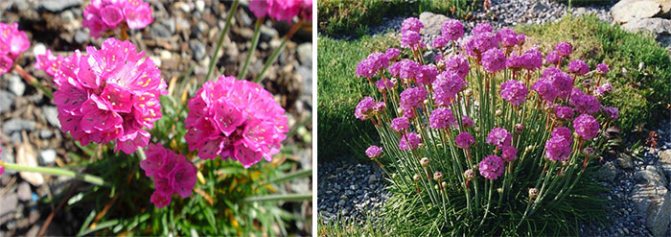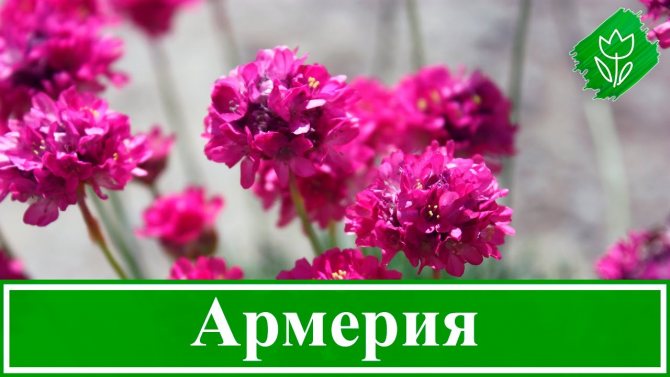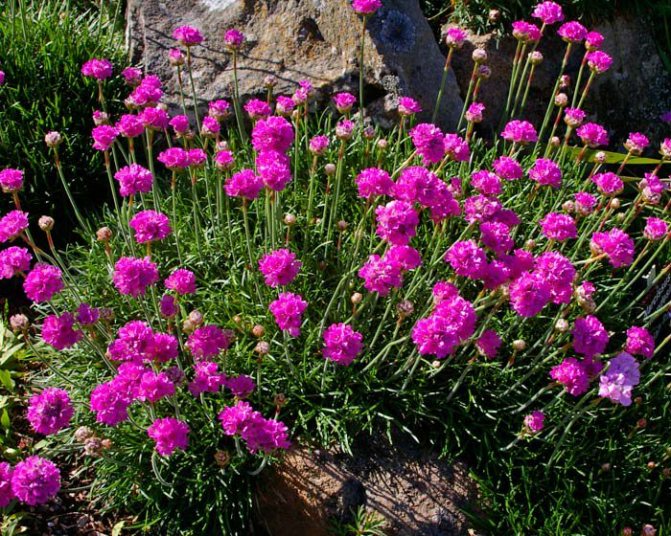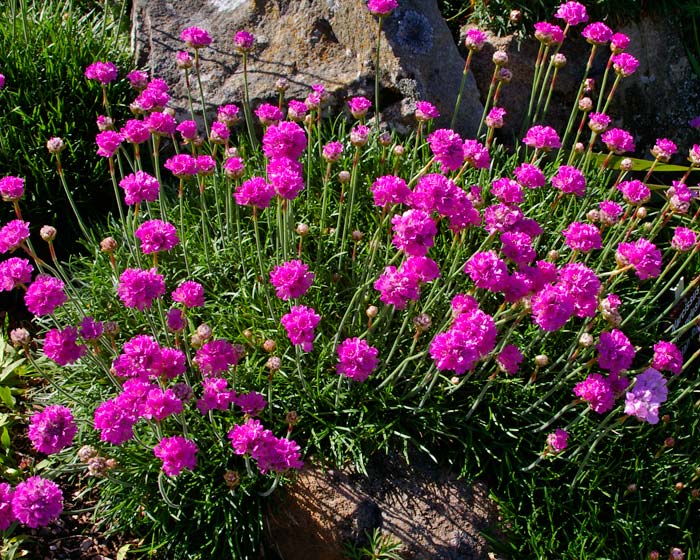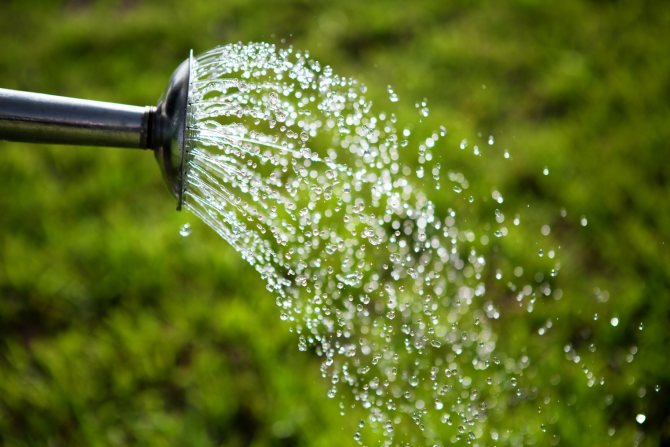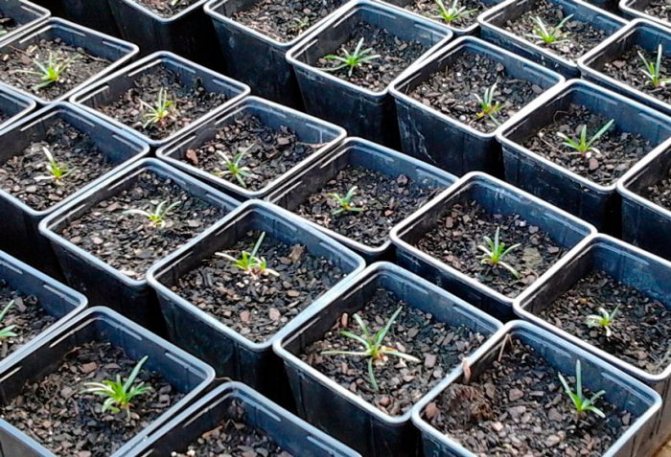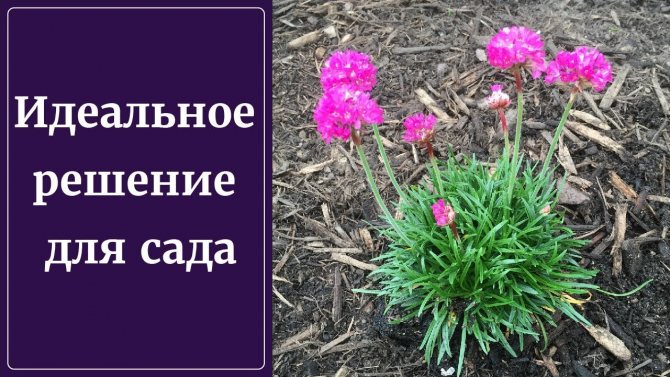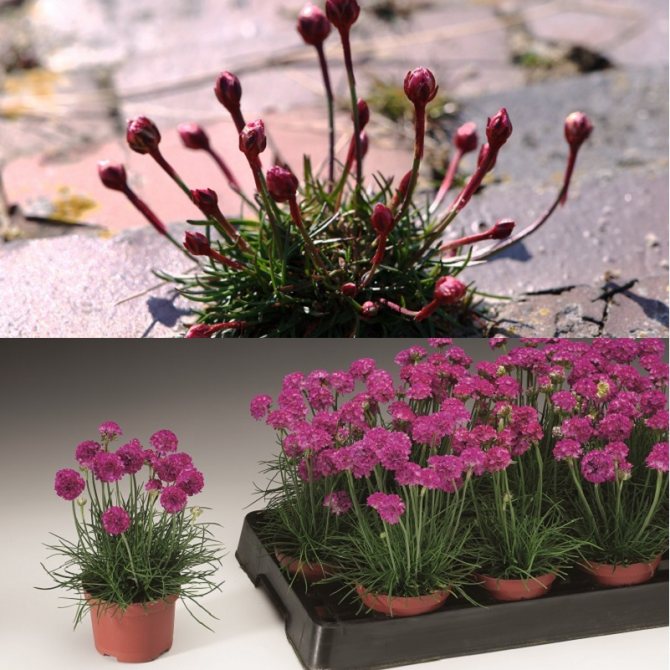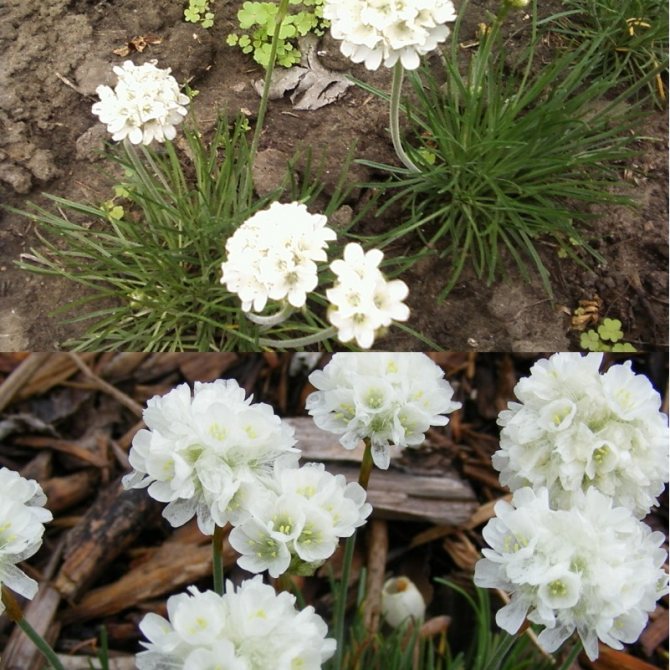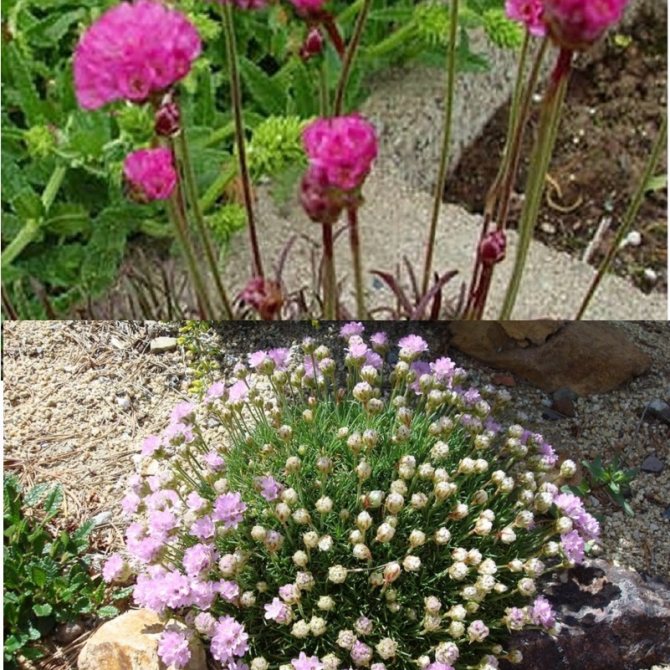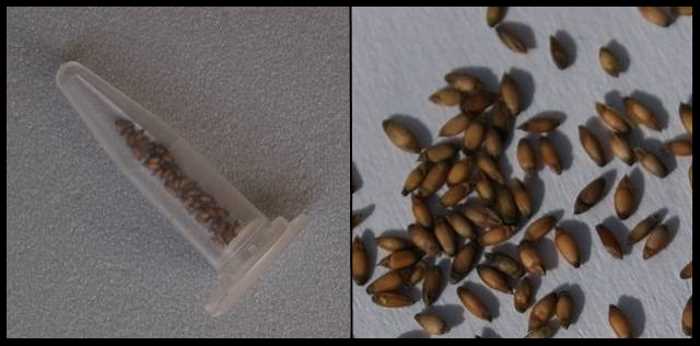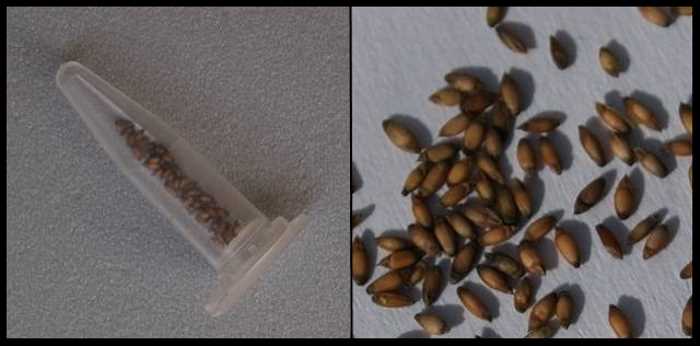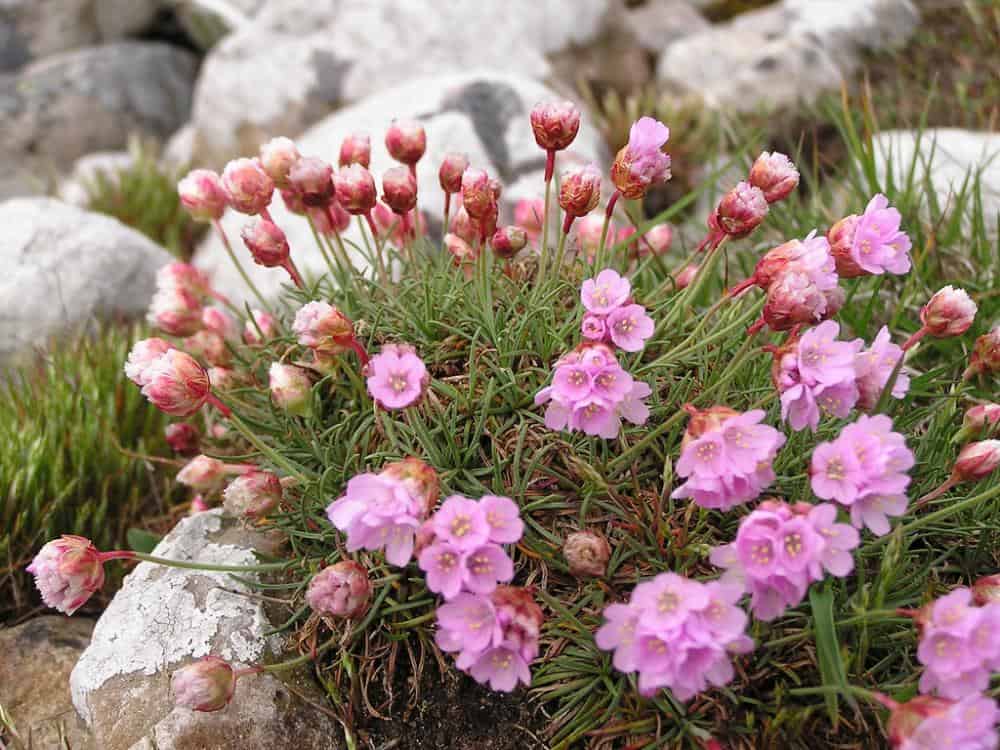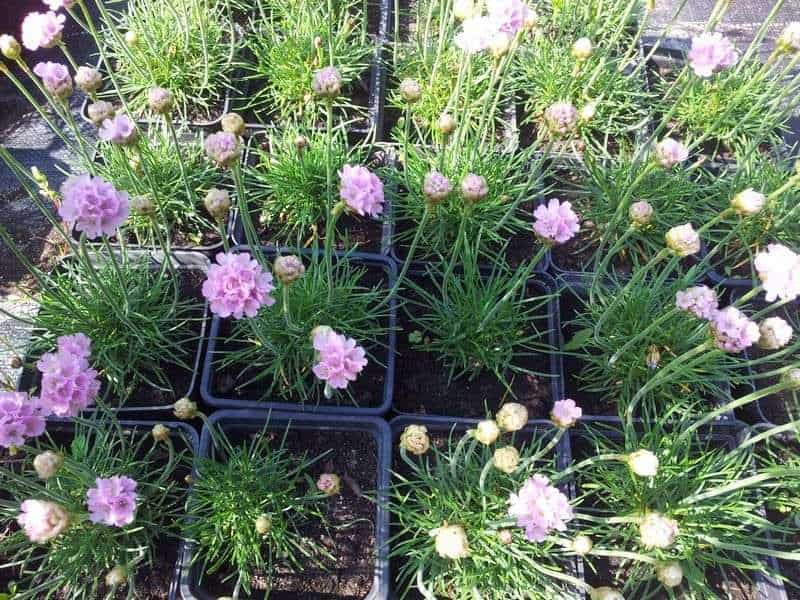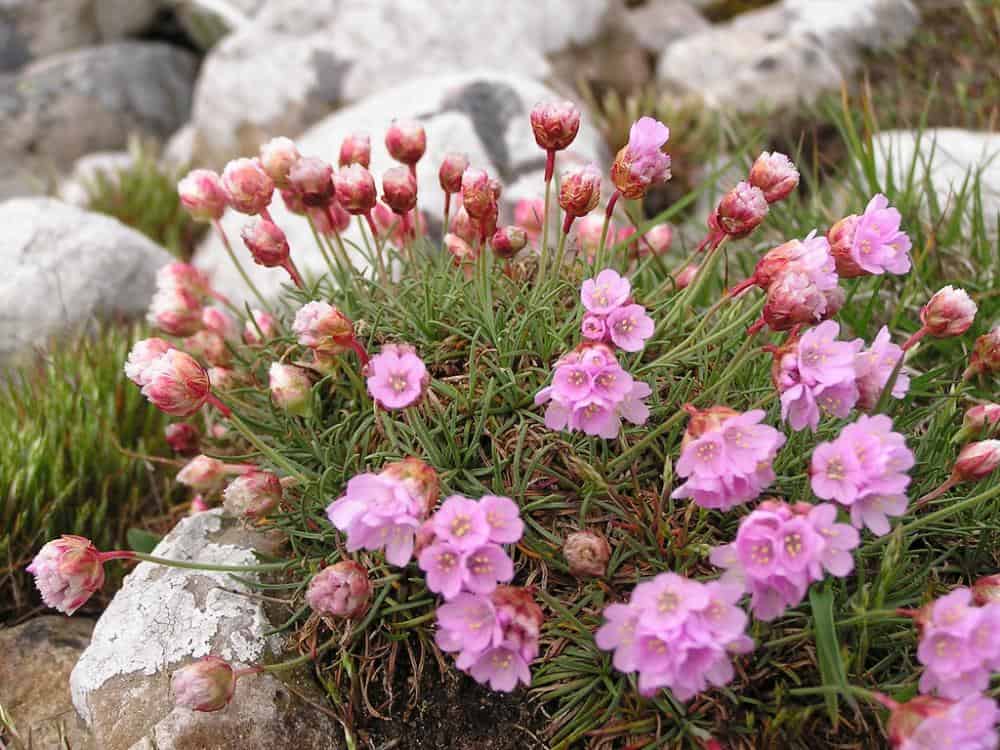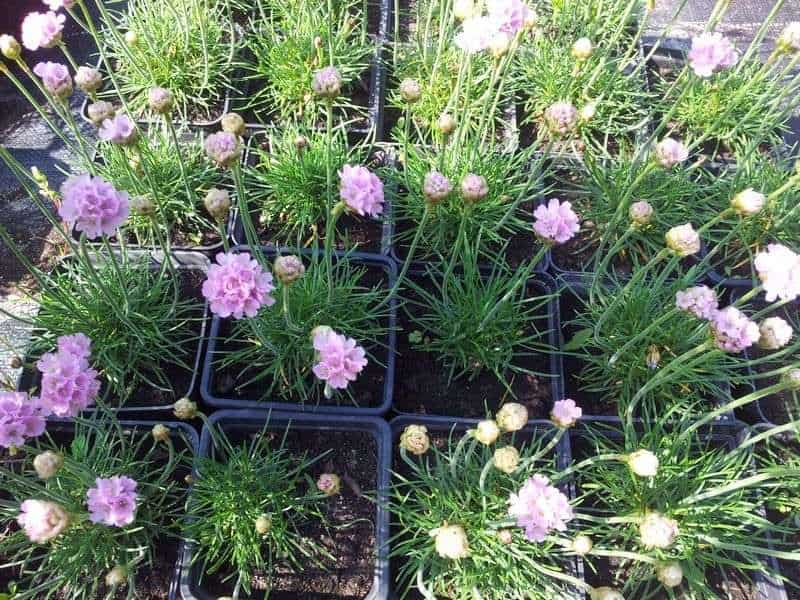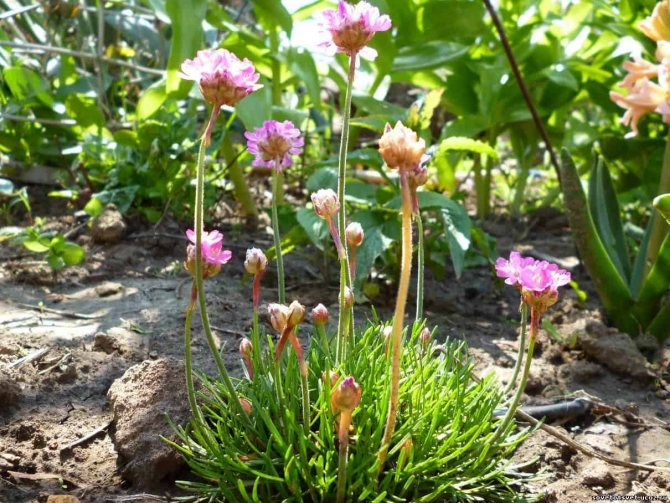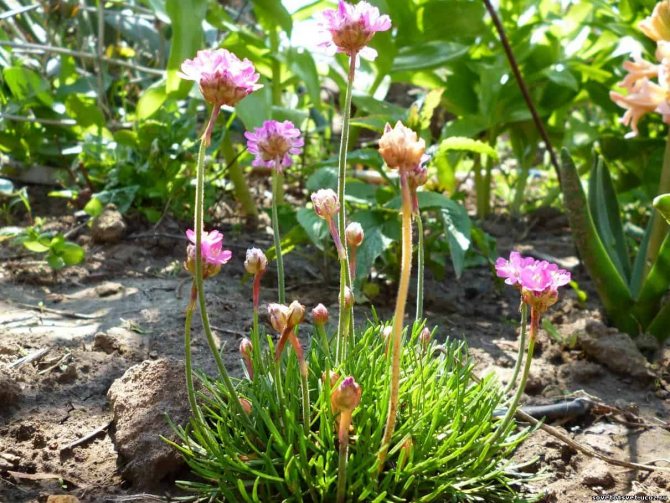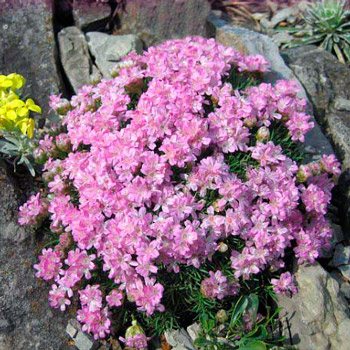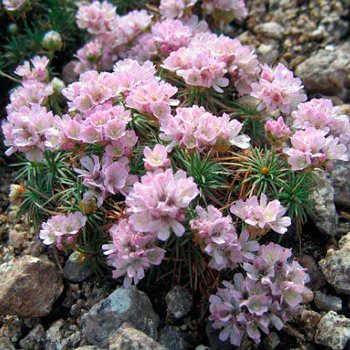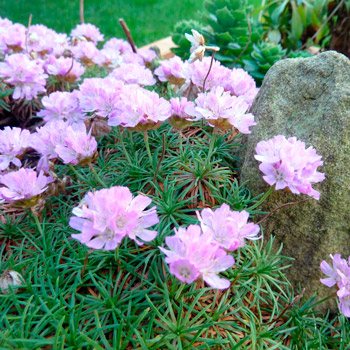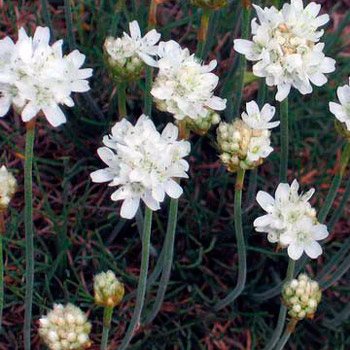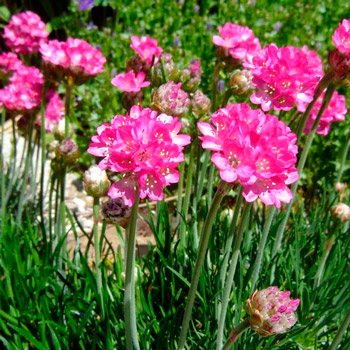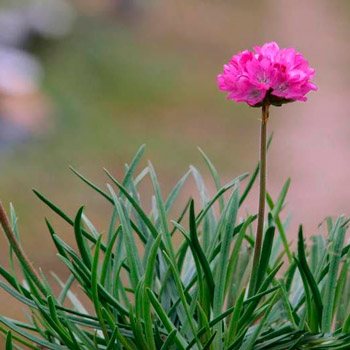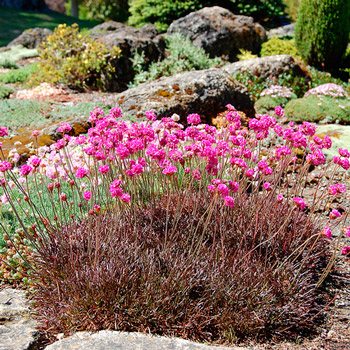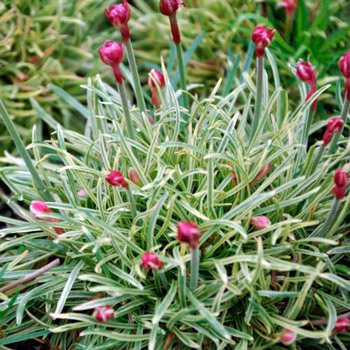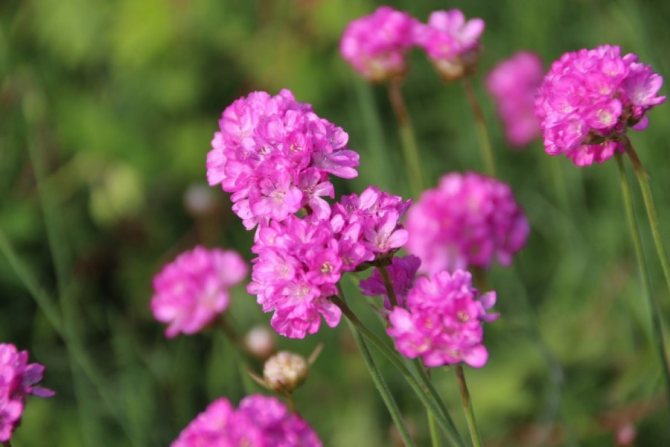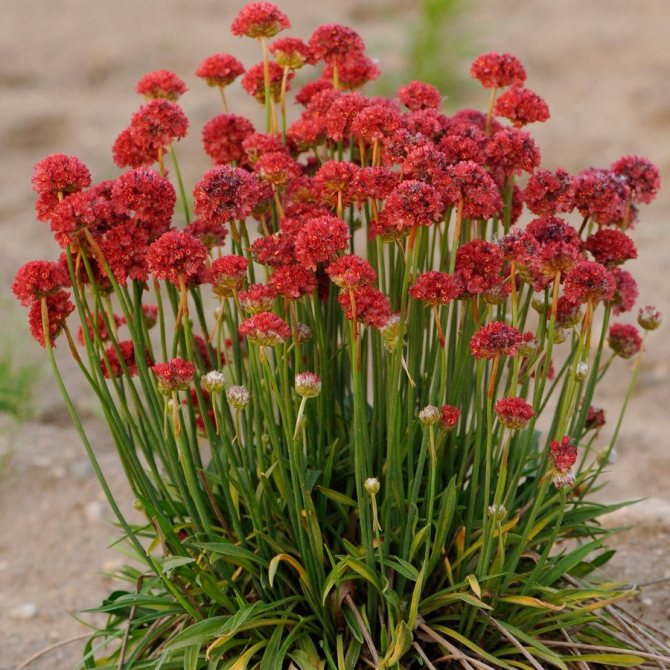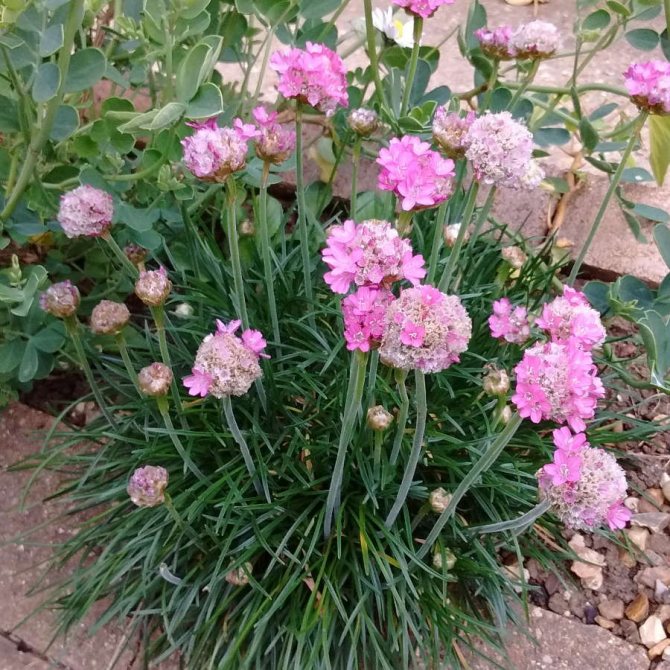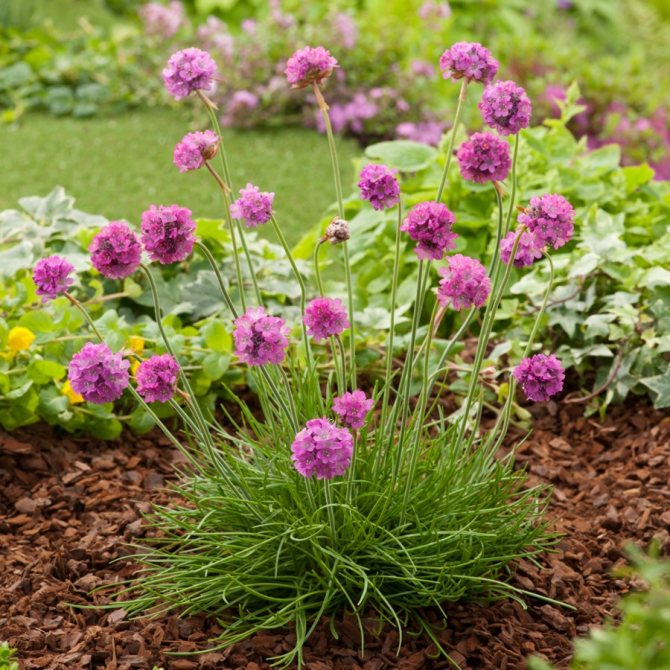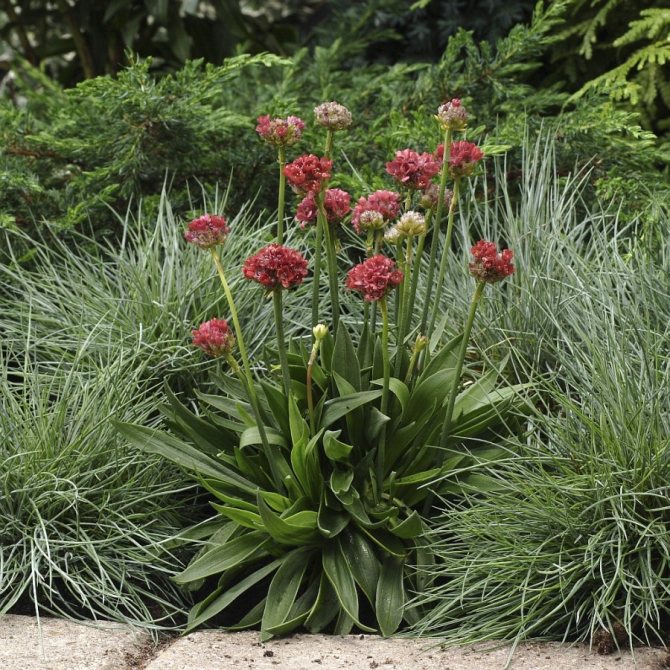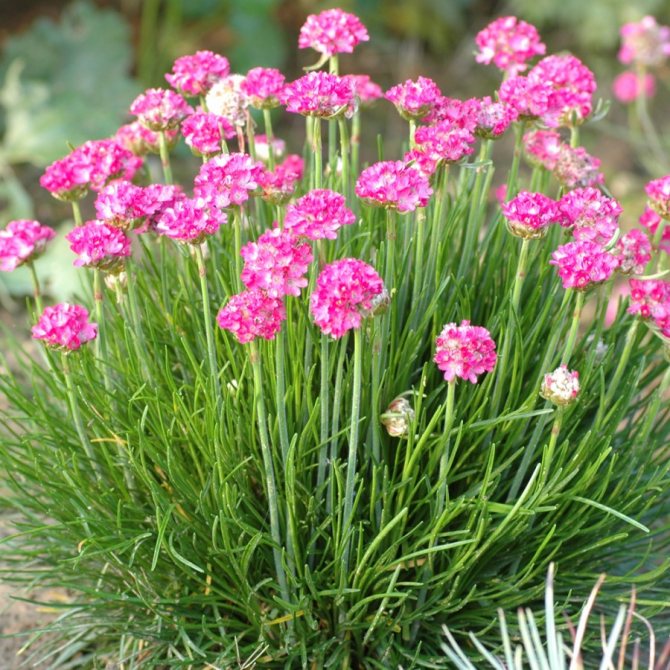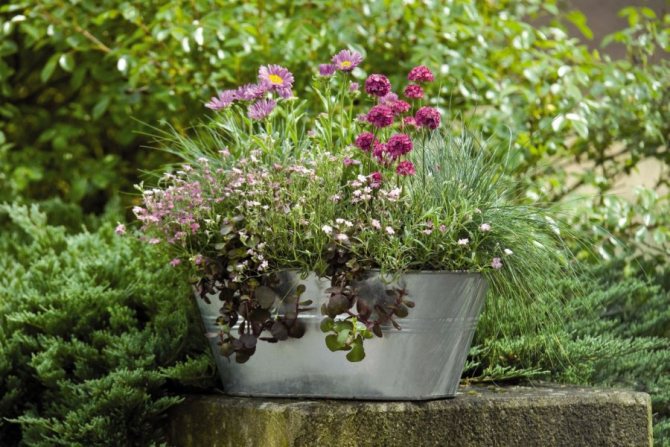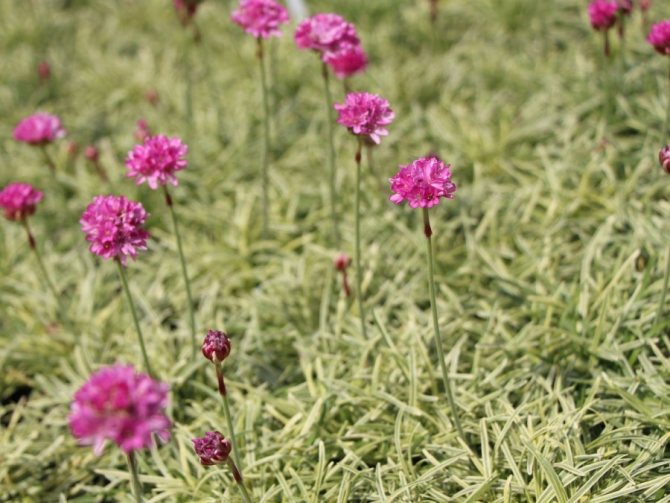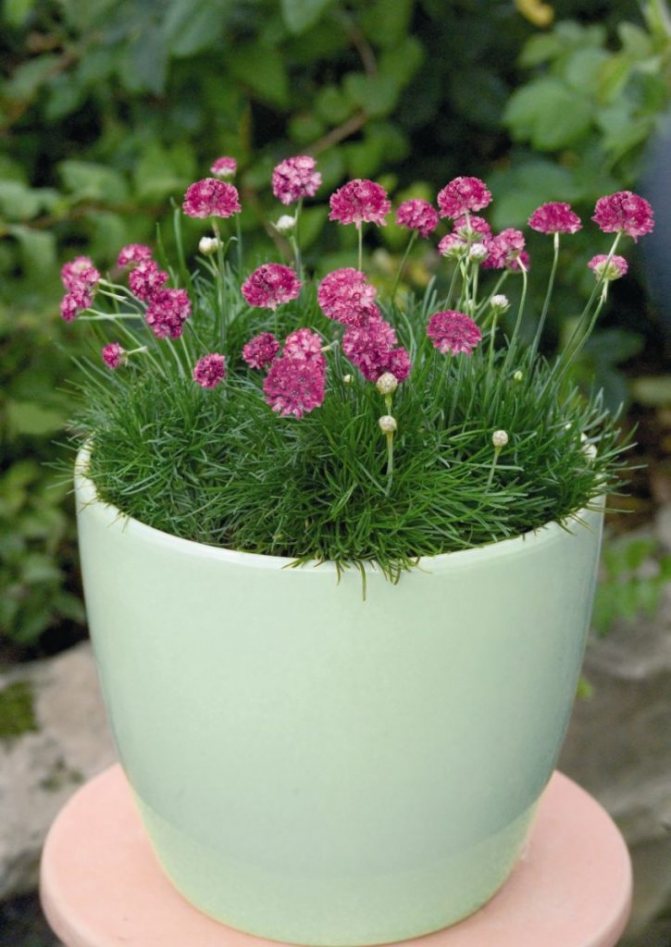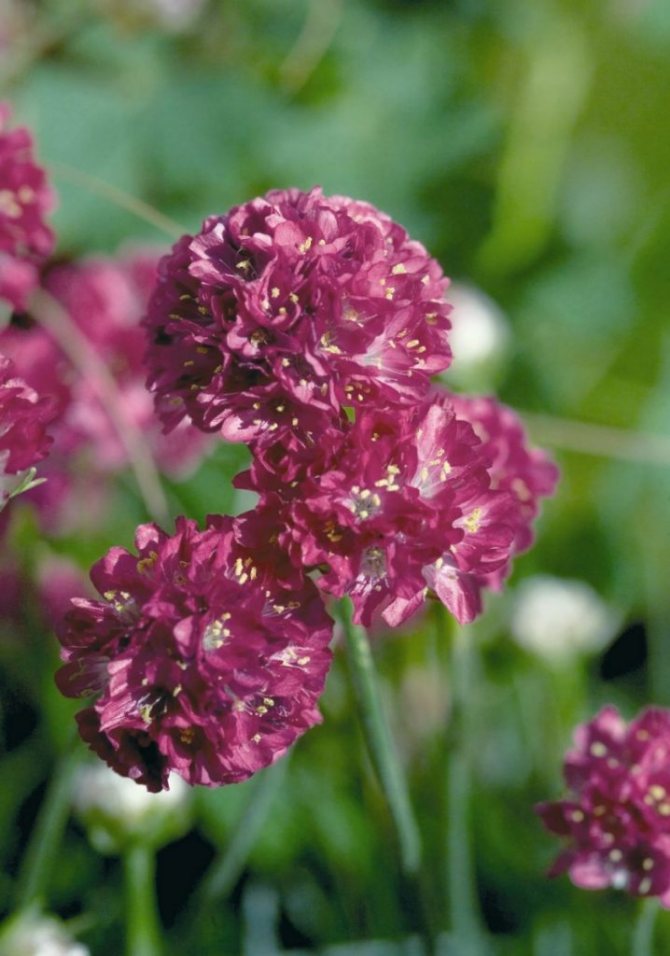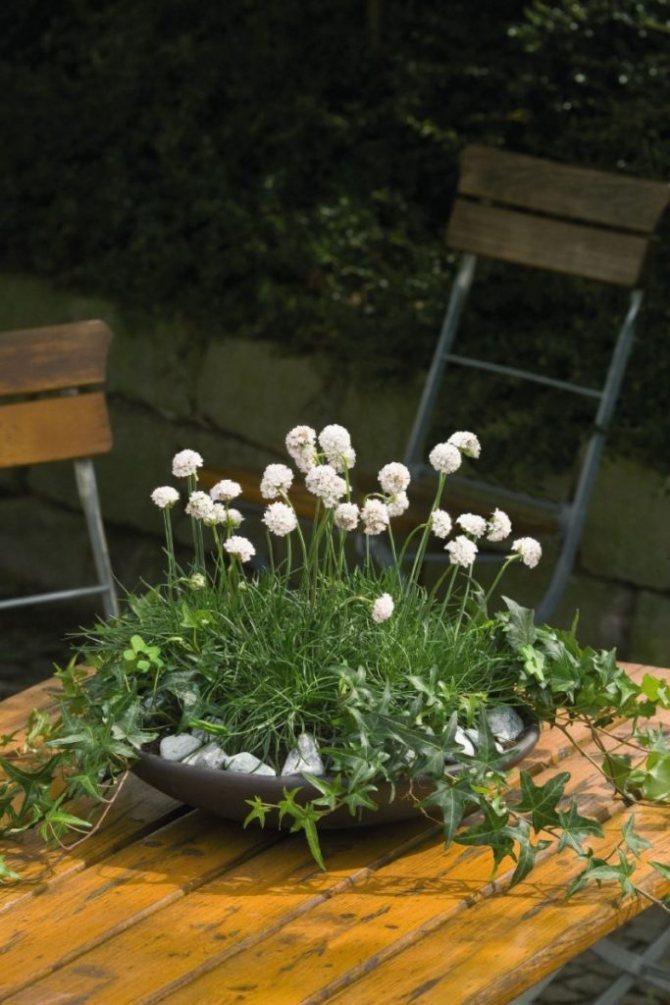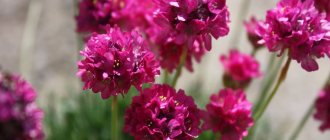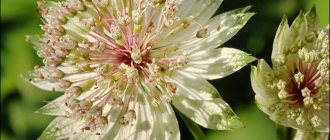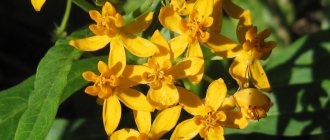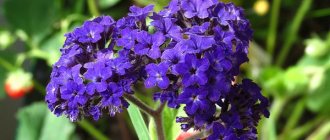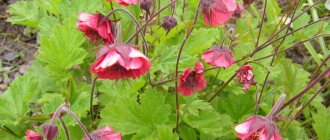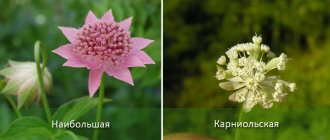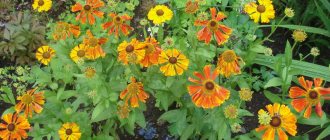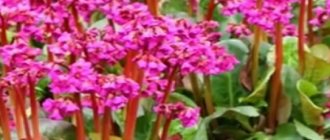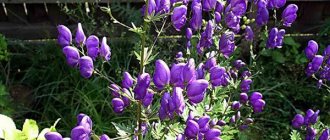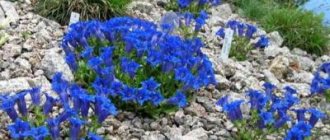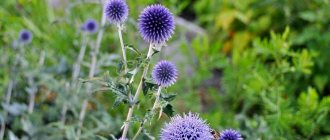Category: Garden Plants
Flowers armeria (lat.Armeria) form a genus of herbaceous flowering perennial plants of the Pig family, numbering in nature more than ninety species. The name "armeria" can come from the combination of two Celtic words: "ar", which means "near, nearby", and "mor" - "sea". The validity of this assumption is confirmed by one of the common types of armeria, which prefers to grow in the coastal dunes. But there is also an opinion that "armeria" comes from the word "armoires" - this is how the bearded carnation was called in Old French, with which some types of armeria are similar. Under natural conditions, the Armeria flower is found in Eastern Europe, the Mediterranean, Mongolia, America and Siberia.
Features of armeria
The height of this flower varies from 15 to 60 centimeters. It has a short tap root. A large number of sedentary all-edge leaf plates having a linear-lanceolate shape are collected in a root socket. In doing so, they form cushions (dense curtains). The straight stem can be pubescent or smooth. Small flowers are part of the capitate inflorescences, while they can be colored pink, white or purple. Single-seeded fruit. Flowering lasts from late spring to late summer. The most popular species is the Armeria maritima. This type of armeria is grown in the same way as all other species, but it should be borne in mind that it prefers to grow in relative proximity to water bodies.
Botanical description of armeria and its photo
Many argue about where such an interesting name came from. Some inept florists say that it came from the name of the country Armenia, considering it the birthplace of Armeria, but in fact the flower is only found there, and that is quite rare. Its homeland is considered by botanists to consider the areas of the Mediterranean Sea. Armeria is often found in the eastern part of Europe and America. A plant of the Siberian armeria species is found in Mongolia and Siberia. In general, many say that the name of the flower is Celtic and is deciphered literally as "near the sea", this is justified by the fact that almost all species grow on the coasts of the seas. By the way, the French believe that this name comes from the old French word, which was called a bearded carnation, which has a fairly large similarity in the botanical description with armeria. We will continue the botanical description, but for now in the photo below you can see that they are really a little similar even in appearance.
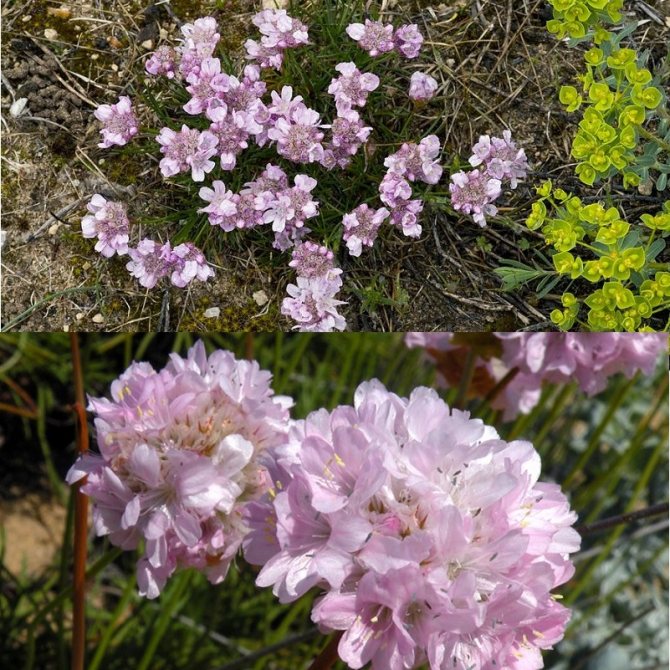
On average, plants of the genus Armeria grow from 15 to 60 cm in height. There are both undersized and more massive herbaceous plants. Botanists characterize them as perennials, but some can easily be grown as annuals (provided that during the winter in the region the temperature drops below -15 degrees). Armeria has a pivotal short root system, the leaves seem to grow directly from it, forming a "pillow" rosette. They are simple in shape with solid edges. The linear-lanceolate leaves lack a root and they seem to sit on the stem and form a dense pillow.In most species, the leaves are numerous, but the shoots are not always and they are often called pedicels, since they also play this role in the structure of the plant.
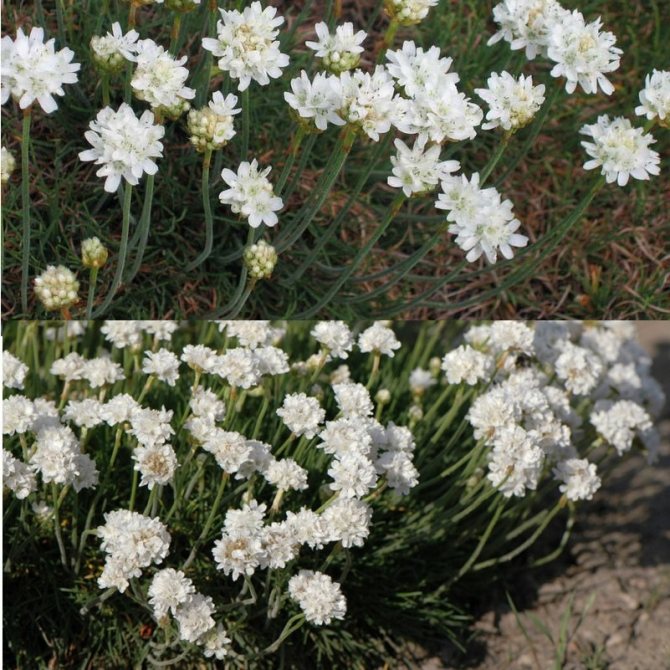

On a straight, smooth or, less often, pubescent stem, there is a capitate inflorescence with beautiful small flowers, the diameter of which rarely exceeds 0.5 cm. The buds are covered with transparent membranous bracts. The plant is monoecious and self-pollinated. After the growing season, a single-seeded fruit is formed, which can be seen in the photo below.
Growing armeria from seeds
Sowing
You can grow a plant from seeds using the non-seedling method, as well as through seedlings. In open soil, seeds are sown at the end of the autumn period, so in winter they will undergo natural stratification. You can also sow in spring in the first days of March. In greenhouses for seedlings, sowing is carried out in the last days of February or the first - in March. Also, the reproduction of this flower can occur by self-sowing. When sowing seeds in open soil, as well as in a greenhouse, you need to take into account that they should not be buried too deep. So, it is recommended to sprinkle the seeds with a 5 mm layer of soil. Such seeds have a high germination rate.
Seedling
In order for the seedlings to be friendly, it is recommended to put the seeds on the refrigerator shelf for 7 days, and then immerse them in lukewarm water before sowing and take them out after 6-8 hours. The crops must be transferred to a well-lit and warm place. After 2 true leaves appear at the seedlings, they are picked into the greenhouses for growing. There they should stay until they get stronger.
Armeria Velvich
(Armeria welwitschii)
The tallest representative of the genus. The leaves are large, up to 10 cm long, 5 cm wide. Pink flowers up to 2 cm in diameter, collected in capitate inflorescences on peduncles up to 35 cm tall. It blooms very profusely and for a long time from June to the first snow. Calcium-rich soil is essential for successful growth.
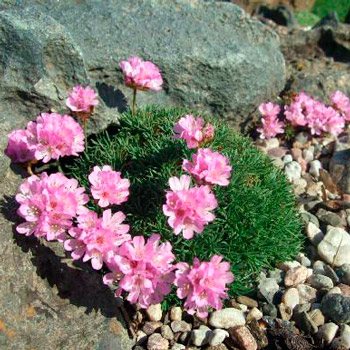

Planting armeria in open ground
What time to plant
After the leaf plates of the plants in the greenhouse become strong enough, they can be transplanted into open ground, but only if the frost does not return for sure. For such a plant, it is recommended to select the most sunny and well-heated area. Suitable soil should be slightly moist and slightly acidic, so rocky or sandy ground is excellent. Armeria does not grow well in soil where there is a lot of lime, so you need to fix it before planting. To do this, it is recommended to add ammonium nitrate to the soil or pour it with an acetic acid solution.
How to plant an armeria
Soil preparation should be done half a month before planting. To do this, it must be thoroughly loosened and organic fertilizers added to it. In the case of growing armeria as a single plant, it must be planted in pre-prepared holes, while the distance between the bushes should be from 30 to 40 centimeters, and they should also be at about the same distance from other plants. Armeria is installed in such a way that its leaf plates are not immersed in the soil, while the root collar should not be too deep. The required amount of soil is poured into the holes, after which it is tamped, and then irrigated. In the event that armeria is supposed to be grown with a solid carpet, a distance of more than 15–20 centimeters should not be made between the plants. Instead of holes, it is better to make not very deep trenches. After planting, the first 3 weeks, you need to water quite often, but you need to water the bushes only after the soil surface dries slightly. The flowering of plants grown from seeds begins only from the second year of life. From seeds, the seaside armeria should be grown in the same way.
Planting and leaving
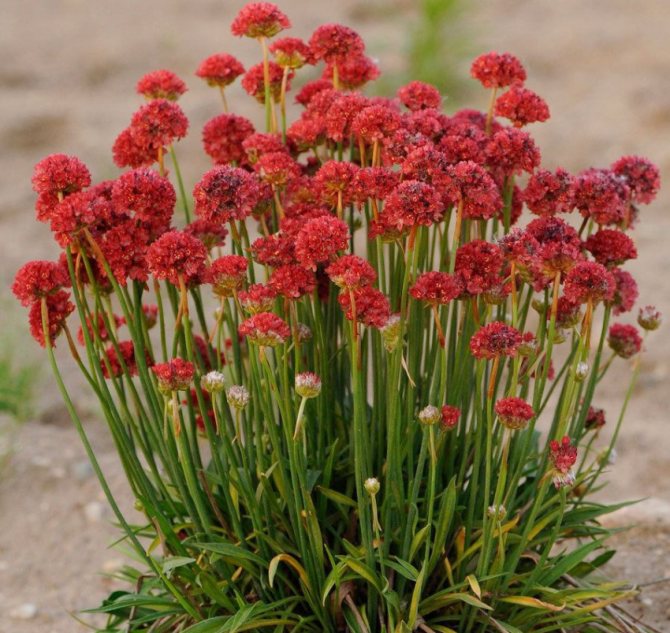

Planting and caring for the seaside armeria is not difficult even for amateur gardeners.However, there are some rules to follow.
The flower of this species loves the sun and is drought tolerant. He needs moderate watering, during the rain there is enough natural precipitation. It is necessary to ensure that the soil has time to dry out between waterings in order to prevent root rot. In hot weather, it is necessary to provide the flower with irrigation by sprinkling.
The soil for planting should be sandy or stony, about 20 cm deep. You can create it yourself using river sand and earth from a greenhouse.
Landing
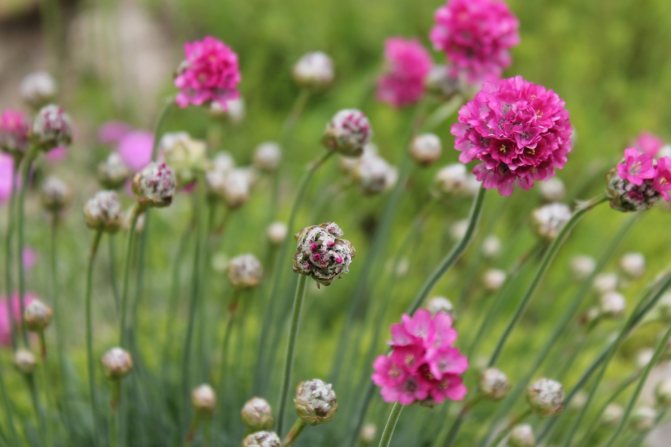

Armeria is a flower that loves light, so it is best to plant it in a well-lit corner of the garden. Before planting, the soil must be pre-prepared by thoroughly loosening and adding fertilizers.
It is necessary to monitor the moisture content of the soil so that the roots do not rot. If the soil is very wet, drainage is necessary.
Depending on whether you want the plant to grow in carpet or in separate sods, it is planted either at close range, or at a distance of at least 40 cm between seedlings.
Pruning
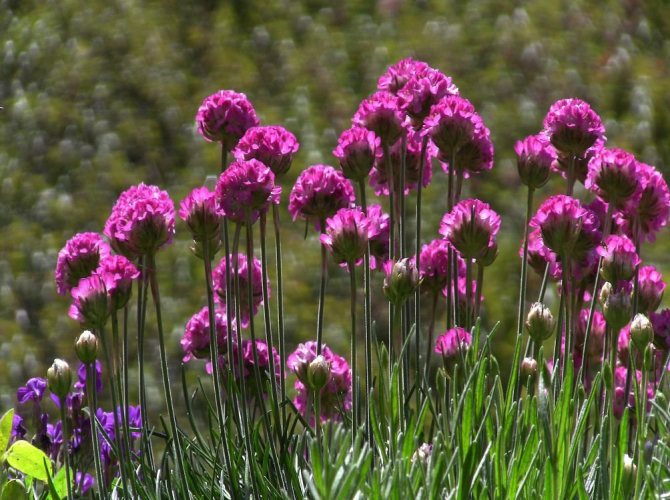

One of the important steps in flower care is pruning. It is necessary to cut off the armeria after the active phase of flowering, using a pruner. This simple method will allow the flower to bloom again in one season, and also will not allow energy to be expended on buds that will no longer bloom.
Wintering
This plant is very unpretentious, therefore it tolerates wintering well. Especially if the winter is snowy. If there is little snow, then it is better to cover the plant with spruce branches or rotted leaves.
Growing
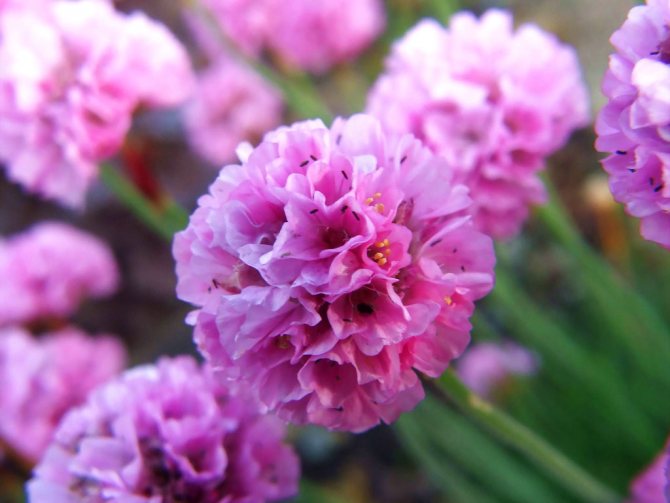

When growing seaside armeria, it is fed three times a season using organic and mineral fertilizers. One top dressing should be mandatory before flowering. Early spring or late autumn is the best time to plant Armeria seeds.
Breeding features
The plant needs rejuvenation every 5-6 years. To do this, you need to dig it up, carefully divide the rhizome and plant it in new places in the garden. Armeria flowers can be propagated using seeds or cuttings.
Growing from seeds
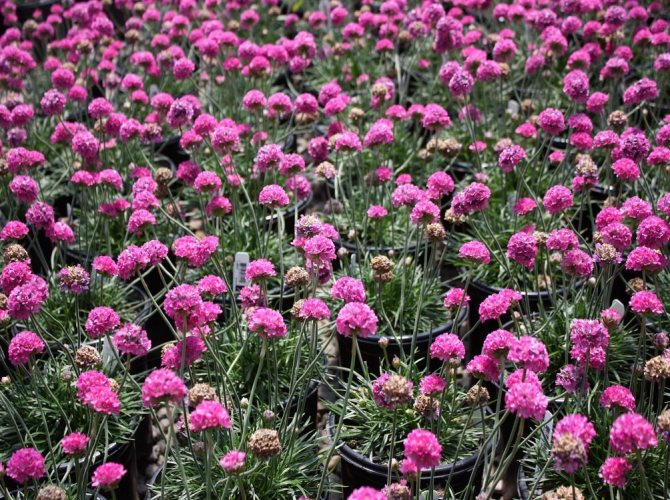

Growing armeria seaside from seeds is possible using seedlings, or in a seedless way.
For armeria, the seaside seedling method is more preferable. The seeds must first be placed in containers. After the plant has grown a few centimeters, it must be transplanted into a greenhouse. And only after the leaves appear, the plant is planted in open ground at a permanent place of growth. It is necessary to monitor the distance between the seeds, since the armeria grows well, the flowers will interfere with each other if they are planted too close.
If you use a seedless method for growing, then it is better to do it in the fall. After lying in the soil all winter, the seeds will sprout in March. Unfortunately, this method is only suitable for temperate climates, since the sprouts will sprout with the first warmth, and unexpected frosts can destroy the plant.
Cuttings
For propagation by cuttings, small rosettes are chosen, which are rooted in the ground in spring or summer. Planted cuttings will germinate well, provided the summer is warm. If the weather is cold, then it is better to cover them with a glass jar so as not to die.
Care features
It is very easy to care for such a flower. Before flowering, it is recommended to apply a complete mineral fertilizer to the soil. After that, the plant is fed in the same way 1 or 2 more times. Fading flowers should be cut off in time, and those peduncles on which flowers will no longer appear should be removed. As a result, the stored strength of the flower will be spent on the emergence of new buds. During the dry summer period, watering should be regular, but the soil should not be overmoistened. After the Armeria turns 5 years old, it is necessary to dig out a bush and divide it into parts, and then plant it. And then this procedure should be done 1 time in 2 or 3 years, otherwise the flower will grow.
Diseases and pests
The plant is highly resistant to various diseases and harmful insects. However, if the acidity of the soil is less than necessary, then the armeria may have problems with spotting or aphids. To combat such misfortunes, radical pruning of the stems is used.
Diseases and pests
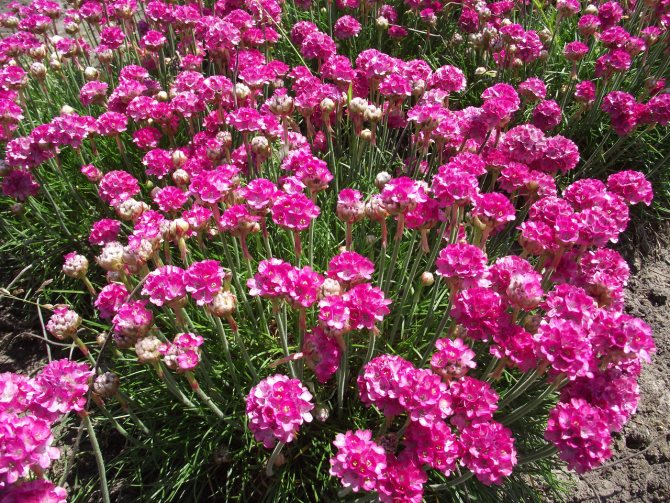

The flower of the seaside armeria is practically not affected by pests, but you need to look to see if aphids have appeared on it. In order to protect the plant, you need to treat it with preventive drugs. It is necessary to ensure that the moisture content of the soil is not increased, as this leads to rotting of the roots.
The acidity of the soil is also important, otherwise stains may appear on the plant. This is dangerous because the flower will slow down or even stop growing. In this case, only cardinal pruning can save him.
Over-watering and over-fertilizing can cause the plant to stop blooming.
Armeria after flowering
Seed collection
In the event that armeria is grown on your garden plot, then there is no special need to collect its seeds, since it reproduces excellently by self-seeding. And you should not forget that the bushes will need to be planted regularly, while dividing them into divisions, and the sowing plants will multiply with their seeds, so the planting material will definitely be enough for you. In the same case, if you want to share the armeria with someone, then it is better to give some of the cut or cut a few cuttings. However, if you are in dire need of seeds, then the inflorescence, which will begin to fade, will need to be tied with a piece of gauze, which will prevent the seeds from falling out to the surface of the soil. A completely dried inflorescence must be carefully trimmed. The seeds need to be shaken out on a leaf. After that, they are cleaned of plant residues. When the seeds are dry, they must be poured into a paper bag.
Perennial wintering
Such a plant is highly resistant to frost, in this regard, they should not be sheltered for the winter, especially if the winter periods in this area are snowy enough. However, turfy armeria needs an obligatory shelter. You can cover the bushes with spruce branches, dry peat, and non-woven material. If a winter with little snow is forecasted, it is better to cover the army.
Armeria soddy
(Armeria juniperifolia)
A perennial plant that forms a dense pad 5-15 cm high, 15-20 cm in diameter. Leaves are narrow, linear, collected in a rosette. The flowers are red or pink in capitate inflorescences surrounded by dry bracts, completely covering the green rosettes. Peduncles 5-6 cm tall. Blooms from July 40-50 days. Old pillows usually disintegrate starting in the center.
Varieties:
| Armeria turfy "Brno" |
| Low-growing variety with double purple flowers |
| Armeria turfy "Lelecovice" |
| Terry flowers, pale pink, peduncle height 5-8 cm |
| Armeria turfy "Bevan`s Variety" |
| Has double, pale pink flowers |
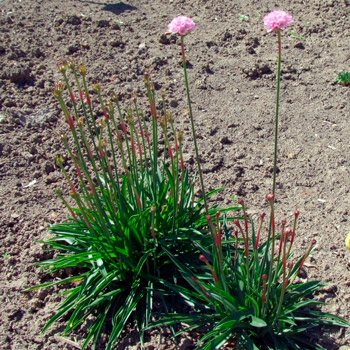

Main varieties and species with photos and names
The most popular among gardeners are about 10 types of armeria. They are grown in ridges, rocky gardens, in group plantings, rock gardens and as colored borders.
Armeria alpina (Armeria alpina)
Such a perennial forms dense cushions that can reach 15 centimeters in height and no more than 30 centimeters in diameter. Most of the linear-lanceolate leaf plates are able to survive during wintering. The capitate axillary inflorescences reach 30 mm in diameter, the color of the flowers is pale pink. The height of the peduncle is about 30 centimeters. Flowering lasts approximately 3-4 weeks and begins in June. Varieties:
- Alba - white flowers.
- Laucheana - carmine red flowers.
- Rosea - deep pink flowers.
Pseudoarmeria, or beautiful armeria (Armeria pseudarmeria)
In height, a bush of this type of armeria can reach 40 centimeters. Evergreen leaf plates are part of the root rosettes. The inflorescences consist of pink or white flowers. Flowering lasts from the first days of June to the last - August. Popular varieties:
- Joystick White - in this variety, the inflorescences have a spherical shape, and they are painted white. In some cases, it is cultivated as an annual plant.
- Thrift - this variety belongs to undersized, while the height of the bush can reach only 20 centimeters.
- Red planet - in such a perennial plant, the inflorescences are spherical and red in color, the peduncles in height can reach no more than 30 centimeters.
- Bees Ruby - the color of the flowers is deep pink, and the height of the bush is about 60 centimeters.
Armeria maritima
Under natural conditions, the plant of this species prefers to grow on the sea coasts. As a rule, the height of the bush does not exceed 20 centimeters. The diameter of the root rosette is also 20 centimeters. Narrow flat leaf plates have a linear shape and a greenish-blue color. The flowers are collected in capitate inflorescences, their color is lilac-pink. The flowers are covered with film bracts. Flowering begins in May and lasts approximately 70 days. In some cases, re-flowering occurs in autumn. Popular varieties:
- Louisiana - this variety has pink flowers.
- Dusseldorf Stolz - the flowers of this variety have a dark red color.
- Vindictive - the flowers of this plant are colored red.
- Bloodstone - inflorescences consisting of small flowers, painted in dark red.
Armeria soddy, or Armeria juniperifolia (Armeria juniperifolia, Armeria cespitosa)
The homeland of this type of armeria is the highlands of Portugal, as well as Spain. The height of this perennial plant can reach 15 centimeters. Narrow leaf plates have a linear shape; they are part of the root rosette, which can reach about 20 centimeters in diameter. The flowers are collected in capitate inflorescences, they can be pink or red. The inflorescences are framed by membranous bracts. The height of the peduncles is about 6 centimeters. This species is distinguished by the abundance of its flowering, so, very often there are so many flowers and inflorescences that they completely cover the leaf plates and stems of the bush. Flowering begins in July and can last 40-50 days. This type of armeria is extremely negative about the stagnation of water in the root system. A hybrid plant created from maritime armeria and turf armeria is very popular, and it is called Zyunderman's armeria. Popular varieties:
- Brno - this undersized variety has purple double flowers.
- Beavans Variety - double flowers have a light pink color.
Armeria Welwitschii
Such a tall species in height can reach 35 centimeters. The length of the large sheet plates is 10 centimeters and the width is 5 centimeters. The capitate inflorescences include pink flowers, the diameter of which is 2 centimeters. Blooms very profusely and for a long time, from the beginning of the summer to the beginning of the winter period. This type of soil needs calcium-rich soil.
Armeria ordinary, garden (Armeria vulgaris)
The flower can reach a height of 60 centimeters. The length of the one-piece linear sheet plates is 12.5 centimeters, and the width is 1 centimeter. At the tops of naked peduncles are capitate inflorescences. They are composed of fragrant flowers of carmine pink color. One bush can have up to 40 inflorescences.
Armeria beautiful (Armeria formosa)
Compact rosettes consist of narrow-linear evergreen leaf plates. Rounded tough shoots are erect. The diameter of the inflorescence is about 5 centimeters, and the color is red, white or pink.Abundant flowering ends only in October.
Also popular are such species as: Japanese armeria, Siberian, prickly, onion, arctic, etc.
Armeria is a herbaceous perennial plant from the Pig family. The name of the culture comes from the words "ar" (near) and "mor" (sea). This is due to the fact that most species of armeria grow in coastal areas. According to another version, the name is based on the French word "armoires" (bearded carnation) due to the similarity of the flower with a carnation. In nature, Armeria is found in Europe, in the southern part of South America, in Siberia and Mongolia.
Armeria is a shrub with an erect stem 15-60 cm high. The root system is short and pivotal. The plant is actively used for landscaping gardens, decorating flower beds. Leaving is not difficult. Armeria can grow in temperate climates, tolerates wintering well and reproduces easily.
Content
- Listen to the article
- Description
- Growing armeria from seeds Sowing
- Seedling care
- When to plant
- How to grow
- How and when to collect seeds
- Armeria alpina (Armeria alpina)
Growing seedlings from seeds
Armeria can be grown from seeds, either using seedlings or in a seedless way. The seedling method is considered more effective. It is better to sow seeds for seedlings in February-March. Before planting, it is recommended to keep them in the refrigerator for a week, and then immerse them in warm water for several hours.
Soil and capacity
Armeria seeds sprout quickly and amicably. They can be sown one at a time in containers or boxes, in peat pots. For planting, it is better to prepare a peat-sand mixture. Fill containers with it. After a week of stratification, the seeds are soaked in warm water for several hours and deepened by 0.5 cm into the ground. Transfer containers with crops for germination to a bright, warm place at a temperature of + 16-20 ° C.
Seedling care
The first shoots will appear in 2 weeks or earlier under good conditions. When the seedlings already have 2-3 true leaves, they are dived into separate pots (when grown in a container or box). They create greenhouse conditions for them so that they grow stronger and grow up. From time to time, the greenhouse needs to be ventilated and moistened by the substrate.
Transplanting
It is possible to plant seedlings in open ground only after it gets stronger and the probability of frost passes on the street, warm weather finally settles. 2 weeks before planting, you need to prepare the site. Loosen the soil, add organic fertilizers. There should be no lime in it. Armeria does not like alkaline soils.
Prepare the pits. Install seedlings in them so that the leaves are not immersed in the ground. It is not necessary to deeply deepen the root collar.
If single plantings of armeria are planned, then it is better to make the holes with a distance of 30-40 cm from each other. If you want the flowers to form a solid carpet, the distance between them should be 15-20 cm.
Description
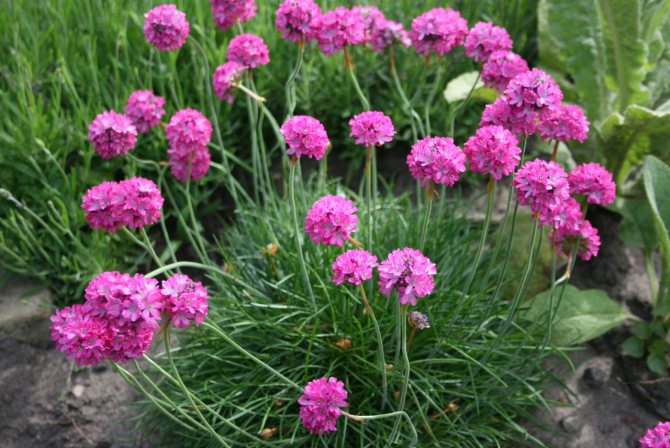

Armeria is a perennial plant that consists of many small flowers on a long, erect stem among bright green pointed leaves, collected in one rosette. Colors range from pink to white. The flowers of this plant are undersized, reach a height of 20-40 cm, and during the flowering period up to 60 cm. The special arrangement of flowers on the peduncle makes it look like a ball.
This plant will bloom for a long time, up to 70 days, starting in May. There are also known cases of repeated flowering.
In winter, they do not require special care, only flowers of the Armeria turfy type must be covered with spruce branches.
These flowering perennials can be grown both outdoors and in containers. Perfectly coexist with other colors.
Seed planting in open ground
This growing method is preferable for the southern regions. Although the flower can multiply by self-seeding.
Sowing dates
Sowing on the street is carried out in the spring or before winter. If the seeds are planted in November, then during the winter they will undergo natural stratification; in the beginning of spring, friendly, strong shoots will appear. Spring sowing does not give such good germination, even if the seeds are pre-prepared and processed.
Location selection and lighting
Under natural conditions, Armeria grows mainly near water. But at the same time, it does not tolerate stagnant moisture. Therefore, it is better to plant it on hills, hills, slopes. It is also preferable to choose areas that are semi-shaded. There should be enough sunlight, but it should be diffused.
The soil on the site should be slightly acidic. Sandy or rocky works well. To make it looser, you can add river sand, turf, rotted needles and dry sawdust. If the soil is alkaline, it is recommended to add a solution of acetic acid or ammonium nitrate to it.
Landing rules
Dig up the site in advance, remove weeds, make the necessary fertilizing. Make shallow grooves. Sow seeds to a depth of about 1-1.5 cm. Sprinkle with soil and water. If sowing is carried out in the spring, then the top can be covered with non-woven fiber to avoid cooling the soil in the event of a return of frost. The emerging seedlings must be thinned out, leaving the healthiest and strongest specimens.
Armeria is beautiful
(Armeria formosa = Armeria pseudarmeria "Formosa")
The plant forms compact evergreen rosettes of green narrow-linear leaves. Stems are round, tough, erect, 12-18 cm tall. The inflorescence is 4-5 cm in diameter. It blooms profusely in June, some flowers appear before October. Inflorescences come in different shades of white, pink, red. Successful cultivation requires an open, sunny location and sandy soil with good drainage.
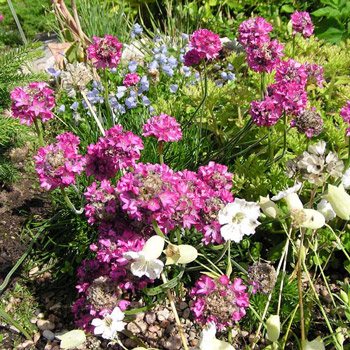

Outdoor care
Taking care of the army is not difficult. Even an inexperienced florist can handle this.
Watering
The flower tolerates drought well. Therefore, it does not need frequent watering. From time to time, you only need to slightly moisten the soil. Moisture stagnation is contraindicated for Armeria, it may die. If long rainy weather has set in the street, it is recommended to make drainage trenches around the bushes so that water flows down and does not flood the roots of the plant.
Top dressing and fertilization
Armeria can grow even in poor soils. But this is bad for her flowering. Therefore, during the growing season, once a month, it is recommended to make mineral fertilizing for flowering crops. They take liquid fertilizers, dilute them with water according to the instructions and apply them to the soil instead of watering. If armeria grows in an area with peat and loamy soil, it can do without additional fertilizing. All nutrients are already contained in the earth.
Pruning
The plant needs periodic pruning. When the flowers fade, the peduncles must be removed with pruning shears. This will allow the plant not only to look more neat, but also to gain strength, to bloom faster next year. It is also recommended to regularly remove dry and damaged leaves.
Varieties of armeria: photo
Protection from pests and diseases
Armeria is very rarely affected by diseases and insects. But with an excess of moisture, the root system may rot, and mottling may appear on the leaves. In such cases, the bush must be dug out, all damaged parts removed, and treated with a fungicide. Transplant the plant to a new location.
Of the pests, aphids are dangerous for armeria.It practically dries up the leaves, as a result of which the plant dies. To avoid this, at the beginning of summer, preventive treatment with insecticides is carried out (Kinmiks, Intavir). If aphids still appear during the summer, the plants must be processed again.
Armeria seaside
(Armeria maritima = Armeria vulgaris)
A cushion-shaped perennial plant, 15-20 cm high and 15 cm in diameter, with narrow, linear, flat, blunt blue-green leaves. The flowers are lilac-pink, collected in capitate inflorescences, covered with membranous bracts. Peduncles up to 20 cm tall, pubescent. Blooms from May for about 70 days, sometimes again in autumn.
It has several forms and varieties:
| Armeria seaside "Alba" |
| With white inflorescences |
| Armeria seaside "Rosea Compacta" |
| Compact bush with pink flowers |
| Armeria seaside "Splendens Perfecta" |
| A dwarf variety with very narrow leaves and deep pink flowers |
| Armeria seaside "Rubrifolia" |
| Has purple flowers and purple leaves and shoots |
| Armeria seaside "Nifty Thrifty" |
| Leaves have a white border around the edge |
Armeria seaside "Vindictive" | |
| The flowers are red |
Armeria seaside "Bloodstone" | |
| The flowers are dark red |
Armeria seaside "Roeschen" | |
| With pale pink flowers |
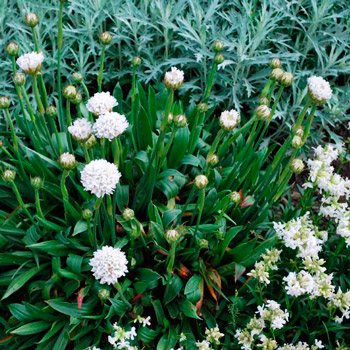

Reproduction
Armeria belongs to perennials. Having planted it once, you can admire the plant for more than one year. In addition to growing from seeds, cuttings are also used, dividing the bush.
Cuttings
The procedure can be carried out throughout the growing season. It is necessary to take root sockets, sprinkle them with soil. If it's warm outside, they quickly take root and take root. If the weather is cool, then the cuttings can be covered with a glass jar, organizing a greenhouse.
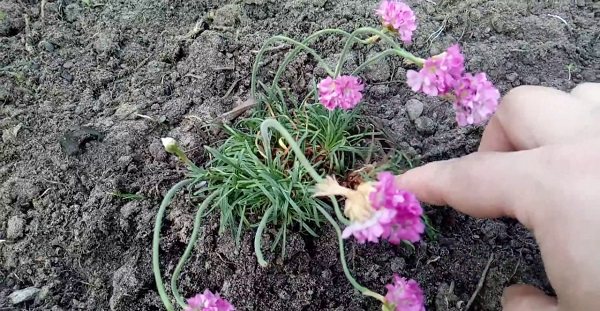

Dividing the bush
The procedure can be carried out when the armeria has already reached the age of 3. The bush grows and requires rejuvenation. At the same time, its reproduction is carried out. At the beginning of spring or autumn, dig up a bush, divide it into equal parts. Remove damaged roots and stems. Prepare the soil in advance. Dig out separate holes for each cut. Dig them in at a distance of 20-30 cm from each other.
As a rule, flowering with vegetative reproduction occurs in the second season. But if you plant a plant in spring, then a small number of flowers may already appear closer to the fall of the same year.
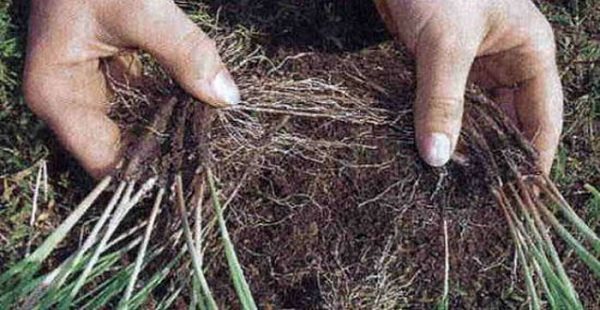

Armeria pseudo-armeria
(Armeria pseudarmeria)
Plant with strong stems up to 40 cm tall. Forms compact evergreen rosettes of green linear leaves. Stems are round, tough, erect. Spherical inflorescence of small flowers of white or pink color. Mass flowering occurs in June, individual flowers appear before October. It has several varieties: "Joystick White" - bright white, spherical inflorescences on strong stems 40 cm. Blooms in the year of sowing and can be grown as an annual. "Bees Ruby" - 40-60 cm high blooms in June-August with bright pink flowers. "Thrift" - 15-20 cm tall.
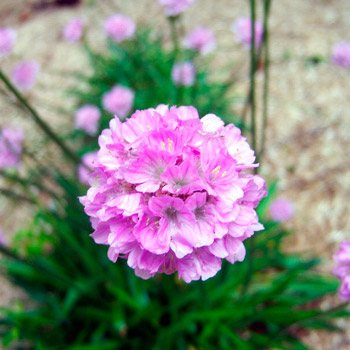

Autumn care, seed collection and wintering
Withered inflorescences should be removed immediately after flowering. You need to leave only those flowers from which you plan to collect seeds. Although armeria reproduces well by self-seeding and dividing the bush. If you need to collect seeds, then the selected flowers, when they begin to fade, need to be tied with gauze. This will prevent the seeds from falling to the ground. When the seeds are ripe, they are poured onto paper, cleaned of impurities. For some time they should be dried and sown in the ground for the winter, or stored in a paper bag until spring.
Armeria hibernates under the snow, there is no need to dig it out. In the southern and snowy regions, you do not need to additionally cover the bushes. Soddy armeria must be spilled. Also, if the winters are frosty and with little snow, then the plants need to be covered with spruce branches or peat. It is important to ensure that there is no accumulation of moisture near the armeria for the winter.This can lead to the death of the root system.
Reproduction of Armeria
- Reproduction by seeds. You can sow seeds directly into open ground in a previously prepared place. For the best germination of seeds, they must be placed in warm water for 7-8 hours before planting. The best time for sowing is early spring or late autumn. You can also take advantage of growing seedlings - sow seeds in boxes placed in a warm place. Then dive the grown seedlings into the greenhouse or into the open ground and cover them with a film. Sowing time with this method: last days of winter or early March.
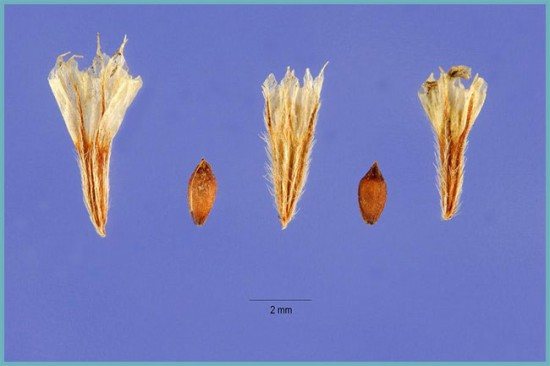

- When reproduction of armeria by cuttings small rosettes should be selected and cut from plants. They need to be planted in the ground. To do this, dig a shallow hole, place a stalk, sprinkle with earth, slightly compact the soil and water. Cuttings should not be planted too deep or they will not germinate. The distance between the bushes should be about 25 - 30 cm. Cuttings can be planted throughout the summer season.
- For reproduction by division use bushes at least two to three years old. This is done in early spring or autumn, when the plant has already bloomed. The bushes should be dug up and cut into pieces. Places affected by rot must be cut, cleaned and sprinkled with crushed activated carbon. The resulting small parts must be planted in open ground at a distance of 20 cm from the bush from the bush.
This section covers all the main points on the topic: armeria growing and care. They will be very useful for flower growers who decide to plant this beautiful plant on their site.
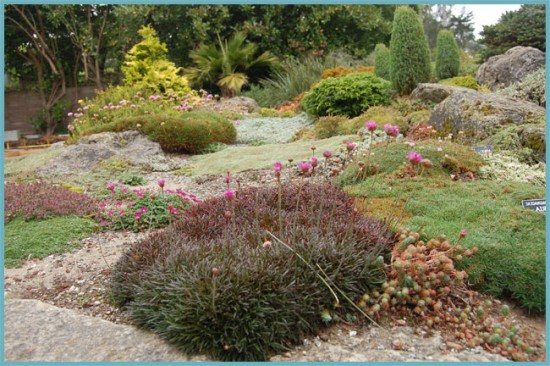

Armeria in landscape design
Armeria stands out for its dense, vibrant vegetation. It is often planted on curbs, ridges, alpine hills. Dense plantings of plants form a continuous carpet that adorns the landscape until the very frost.
On flower beds, Armeria goes well with:
Monoplants from various varieties of armeria look spectacular. These flowers retain their appearance well after drying. They can be used to make dry flower arrangements.
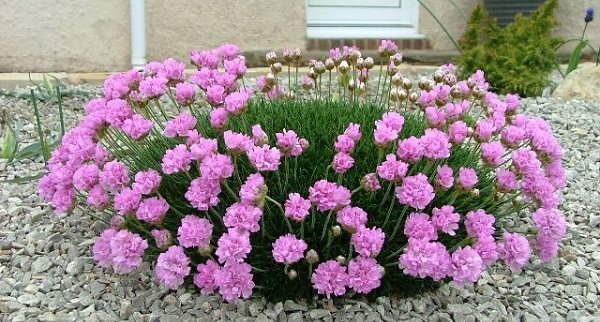

More useful information about growing a beautiful, unpretentious perennial on the site, as well as about the features of caring for Armeria, can be found in the following video:
Armeria care
How to grow an armeria
Caring for the army is not difficult. Before it blooms, apply full mineral fertilizer to the soil as a top dressing, and then repeat the top dressing once or twice. Remove wilted flowers in time and cut off peduncles, which will no longer have flowers, so that the plant directs all its energies to the formation of new buds. If the summer turns out to be dry, water the armeria, but try not to overdo it with moisture.
- Yaskolka: growing and care in the open field
When the plant reaches the age of five, it must be dug up, divided into parts and transplanted, and then it should be done every 2-3 years, otherwise the armeria will grow. This is how the planting of an armeria and its care is carried out. It's simple.
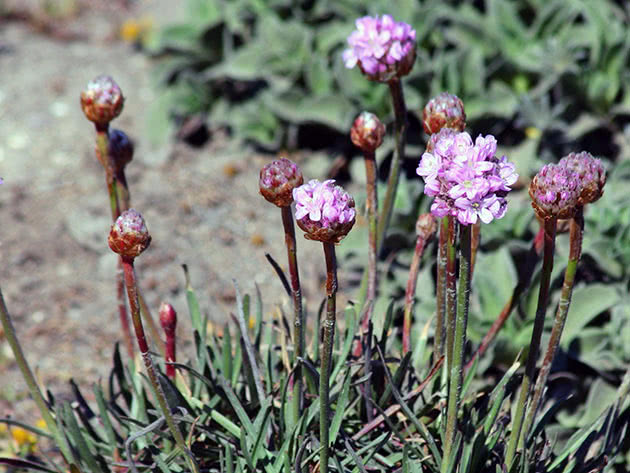

Armeria pests and diseases
Armeria is not afraid of diseases or pests, but if it grows in insufficiently acidic soil, problems with aphids or spotting may arise, which are best dealt with by radical pruning of the shoots.
Role in garden design
Armeria is used in the preparation of garden compositions... Low-growing varieties are planted in flower beds, flower beds. Can be used as a curb along garden paths and alleys.
The decoration of stone gardens and rock gardens is also not complete without this culture, bright flowers dilute low coniferous bushes, complement various creeping "rugs".
It is possible to use the plant as an ampel planted in pots for the decoration of terraces and balconies, awnings and other vertical structures.
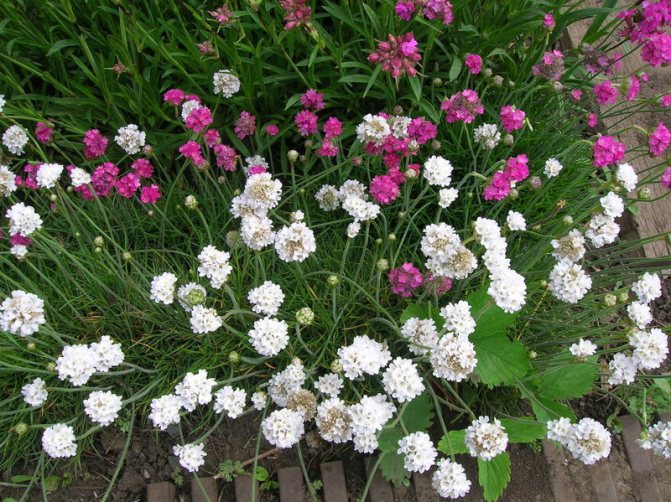

Popular varieties
Armeria has been used in horticulture for a long time, during this period many varieties have been bred.Each type of culture, despite the obvious similarities and common features, has its own differences. The most common varieties are:
Alpine (Armeria alpina)
The most popular type of flower, the height of an adult bush is close to 30 cm. Flowers with light pink petals appear in June and continue to delight the eye until the end of the summer season.
- Alba. It has small white flowers.
- Laucheana has reddish petals.
- Rosea. Deep pink flowers.
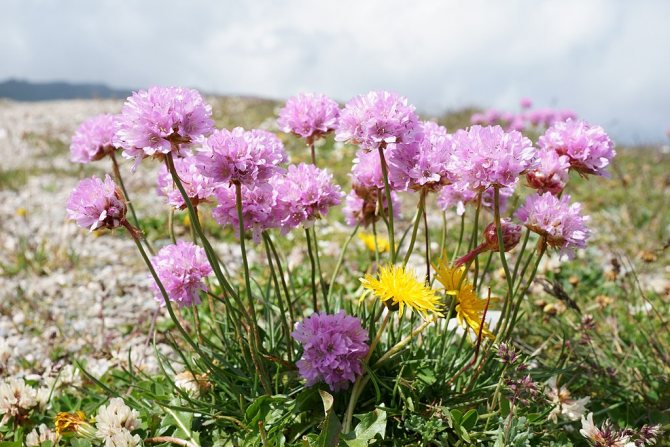

@Xulescu g, Wikimedia Commons
Primorskaya (Armeria maritima)
Another variety often used in horticulture. Reaches a height of 20 cm. The color range varies from lilac-pink to burgundy. The flowering period is one of the longest at 70 days.
- Louisiana - a variety with pinkish flowers.
- Dusseldorf Stolz. Small flowers are close to burgundy.
- Vinidictive - red flowers.
@ Ghislain118, Wikimedia Commons
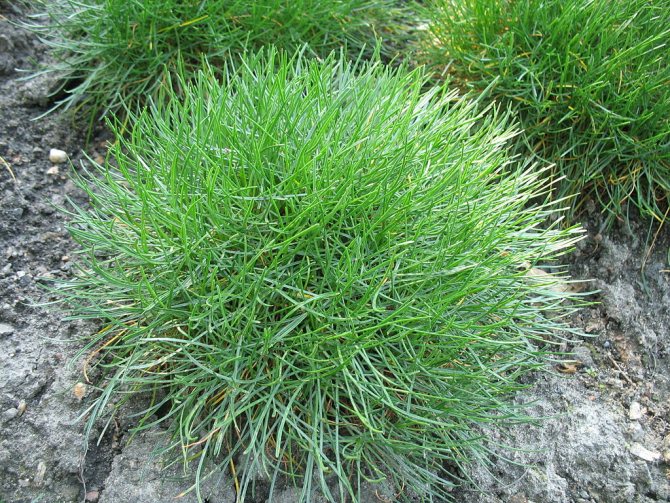

@Tomasz “Nemo5576” Górny, Wikimedia Commons
Soddy (Armeria juniperifolia)
The most capricious variety, with a fairly large set of rules for cultivation and reproduction. This variety is quite sensitive to low temperatures and does not tolerate direct sunlight. At the same time, its flowers are recognized by many experts and amateur gardeners as one of the most beautiful.
- Brno. Lilac flowers on a short bush.
- Bivenz Variety. Light pink double flowers.
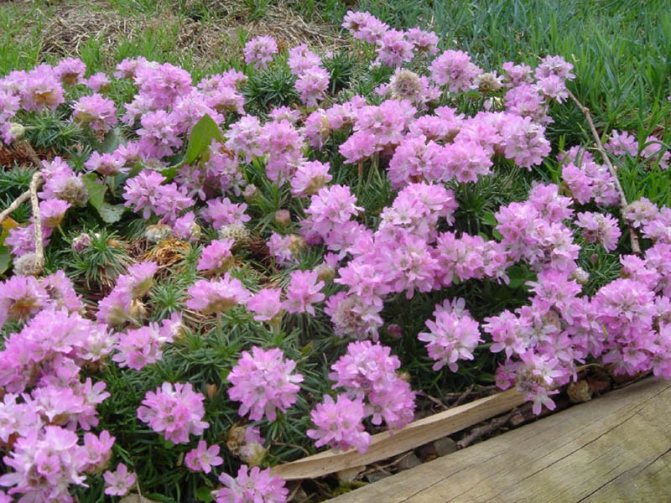

@ Ghislain118, Wikimedia Commons
Velchiva
Above many other varieties, its flowering is one of the most abundant and longest lasting. The main feature during maintenance is that the soil must have a significant calcium content.
Common (Armeria vulgaris)
It grows up to 60 cm, the leaves are narrow (about 1 cm) and elongated. Leafless flower stalks are crowned with beautiful carmine-pink inflorescences, which can include about 40 flowers with a delicate, pleasant aroma.
Other varieties are familiar to modern gardeners: beautiful, Japanese, Arctic, Siberian and others.
Preparing the soil before planting
- If the land on the site is not stony and sandy, then you will have to make 20 - 25 cm of self-prepared soil. To do this, you need to mix a little greenhouse soil, river sand and turf.
- Armeria does not like drafts, so you need to choose a calm place.
- The soil is neutral or slightly acidic. Complete absence of lime.
- Before planting plants in the ground, the soil should be well fed. For this, organic fertilizers are applied (needles, humus, dry grass, small sawdust).
- If you want to make separate bushes, then the distance between the seedlings is at least 40 cm. And if you make an armeria in the form of a whole continuous area, then the distance between the shoots is reduced by 2 times.
- You do not need to dig deep holes. Some make narrow trenches. The neck of the root should be above the ground.
- At the end, the plant is watered moderately so that there is no stagnation of moisture. The soil is compacted.
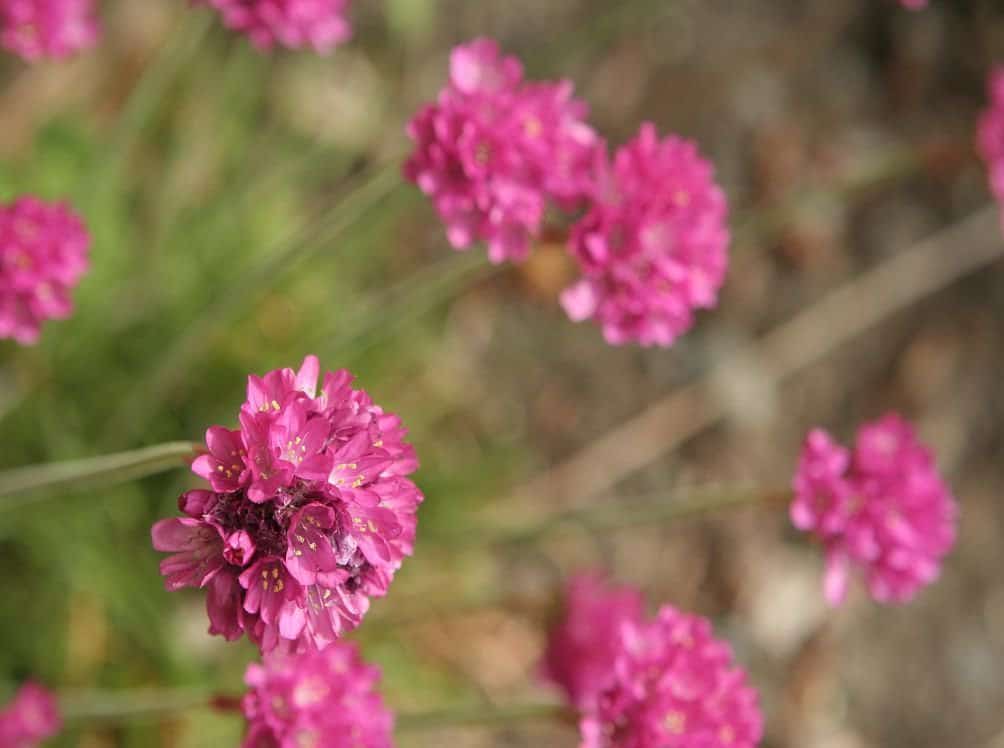

Vegetative development
The regular appearance of basal processes allows you to effectively divide the bush. If it is excessively overgrown, then the division is separated, and then the armeria is planted in another place on the flower garden with an indent of at least 20 cm.
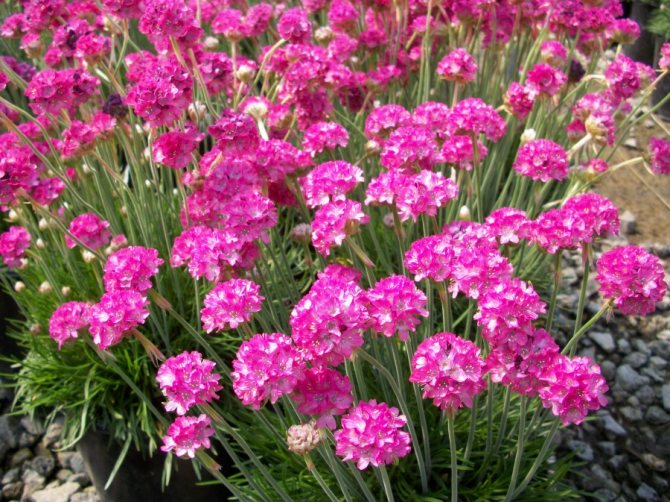

The first time such an operation is allowed to be carried out when the plant has reached the age of three. The best time is the end of summer after the end of flowering. The bush must be dug out, shaken off the ground and the root must be divided into several parts. Each part to be removed must have a strong root system.
In summer, you can separate the stalk from the plant. For this, a rosette without roots or with a weak rhizome is cut off. To root outdoors, the cutting is planted in loose soil. The soil must be drained.
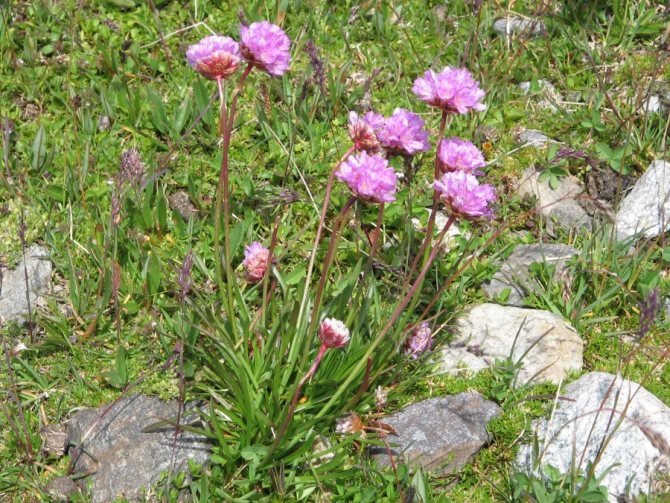

The planted cutting is covered with a protective cap, ensuring its regular ventilation. Watering is necessary only when necessary.
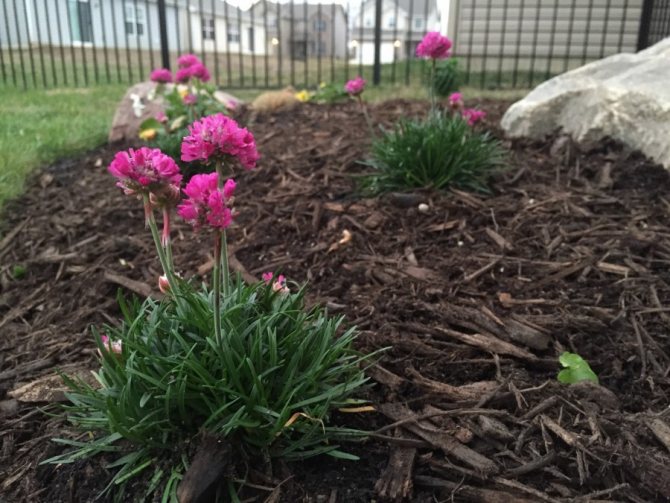

Care rules
This is an unpretentious plant that can grow even in poor soil, but such a bush will not bloom abundantly. To achieve a large number of flowers, you need to apply mineral fertilizers.
Frequent watering is not necessary, but sometimes you need to moisten the soil a little. Avoid over-watering, it is detrimental to the armeria. If the bush has not been divided for 5 years, it may begin to die.
If the number of bushes is sufficient, prune the weakest parts and dig in what is left.
The flower is frost-resistant, if there is a lot of snow, then there is no need for additional shelter. In a snowless winter, cover the bushes with sawdust or pine needles. The rotten "shelter" will become organic fertilizer.
Prune periodically. When flowering is complete, cut off the flower stalks. After such an operation, a second flowering of the season is possible. In addition, pruning will make the shrub more aesthetic.
Landing
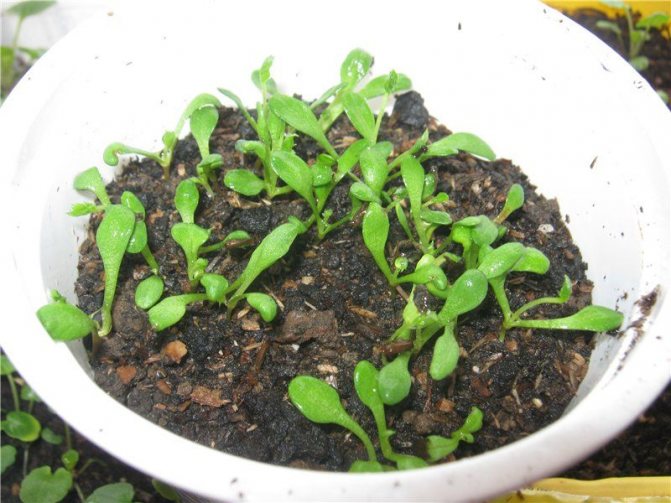

Most gardeners trust Armeria Seaside to create their garden to be beautiful and cozy. But in order to achieve a certain result, to enjoy the splendor with the beauty of a flower, you need to know how to properly plant in the ground, and then take proper care of it. A lot can depend on the choice of the place and time of landing. Usually, seeds are planted in the ground by the beginning of May, and choosing the right place for planting requires the most careful approach for this mission. The main qualities that the planting soil should have are solar activity and the absence of excess moisture, because water can cause significant harm to the flowering of the plant. It is better not to plant the seeds of Armeria in the shade, since they may not grow here and cease to exist.
Views
There are more than 10 varieties of armeria, which are used in various landscape compositions. The flower looks great in rocky gardens, alpine slides, group and individual plantings.
Alpine
A perennial that forms flowering stems 30 centimeters high. Inflorescences are large, delicate white with a pink tint. Blooms all June. Due to the original shape of the leaves, it is highly decorative even without the presence of flowers.
Beautiful
An evergreen perennial that blooms all summer. The height of the plant depends on the variety: from 20 to 60 centimeters. The species is distinguished by good frost resistance and persistent immunity to fungal diseases. Armeria beautiful is often used in individual plantings.
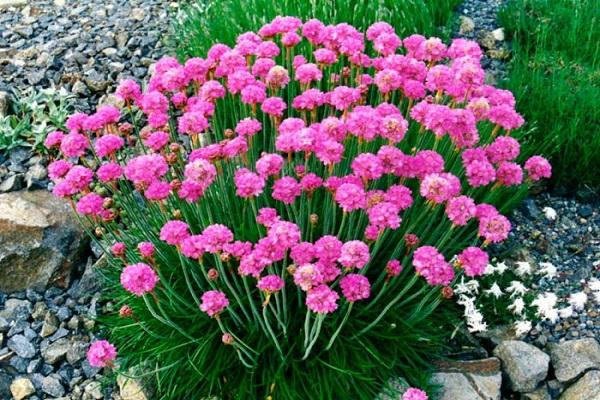

Primorskaya
A magnificent flower blooms from mid-May, it can form decorative thickets. Peduncles are elongated to a height of 30 centimeters, form beautiful spherical inflorescences. Armeria maritima is an unpretentious plant with a high degree of drought tolerance. Bushes look beautiful in individual plantings along the edges of artificial reservoirs and in alpine slides.
Soddy
A low-growing perennial used to create carpets. It begins to bloom from mid-July to late September. With proper care, it forms a large number of flowers, due to which the leaves become invisible.
Juniper
The homeland of this species is Spain and Portugal. Bushes of short stature, completely covered with large spherical flowers. Suitable for carpets. The leaves resemble juniper needles.
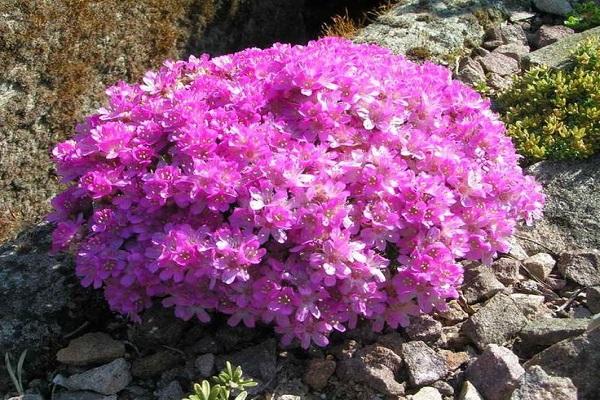

Lovely
An evergreen unpretentious perennial with a grass-like leaf shape. Forms long stems with spherical inflorescences, the diameter of which can reach 7 centimeters. In landscape design, it is used to decorate rocky gardens.
Arctic
Biennial herbaceous flower up to 20 centimeters high. In the second year, the Arctic armeria fades and dies, under natural conditions it can grow for several years. The diameter of the inflorescences is 2 centimeters; during flowering, it gains up to 10 peduncles.
See also
100 types and varieties of garden bells with a description, planting and careRead
Velvich
Tall herbaceous perennial, reaching a height of 50 centimeters. The leaves are pointed, elongated, but wide enough for armerias. Blooms profusely all summer. The diameter of the spherical inflorescences is 2.5 centimeters.
Ordinary
The second name is garden armeria, it can reach a height of 60 centimeters. During the flowering period, it forms up to 40 peduncles.The flower has a fragrant aroma and resistance to cold snaps and temperature extremes.
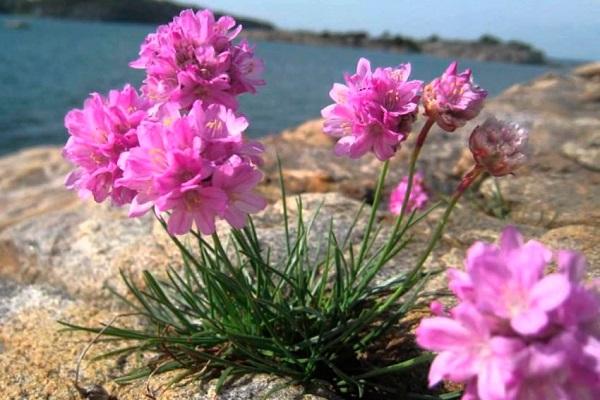

Planting methods for armeria
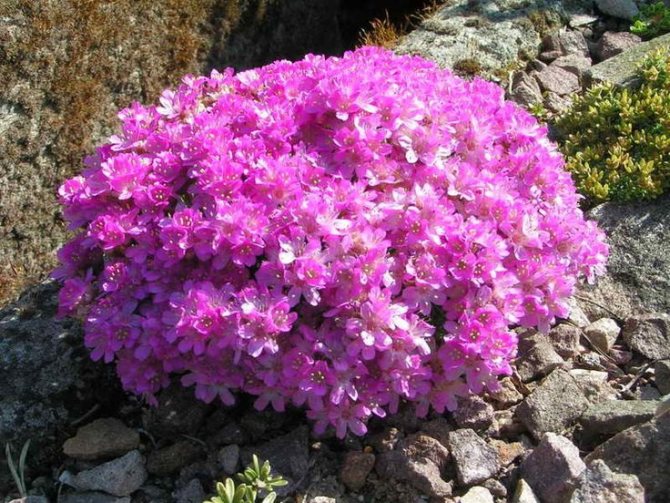

Armeria juniper planting by seeds
There are several traditional ways to do this:
- planting with seeds in open ground;
- growing with seedlings;
- reproduction by dividing the bush.
In order to germinate as many seeds as possible, a week before sowing, they must be placed on the vegetable shelf of the refrigerator. And then, immediately before sowing, soak in warm water with the addition of "Zircon" or another similar preparation for 7-9 hours. This manipulation must be carried out both for seeds that will be sown in open ground, and for seeds from which seedlings will be grown.
Armeria planting, care and fertilization
Although Armeria is an unpretentious beauty, you need to plant it with all the inherent rules, and also take care of it along with other plants.
To accommodate bright shrubs, sunny meadows are required, on which shade is a rare guest. The soil should be light, moist, and loose. An excellent option is sandy loam soil with low acidity or stony damp earth.
In no case is it recommended to plant on a soil rich in limestone. In such areas, the shrub will immediately die.
You should not allow stagnation of moisture in the area where Armeria sits. If this happens, you can lose some of the plantings - the process of root decay occurs quickly. In case of frequent stagnation, it is recommended to provide good drainage for the plant before planting.
If the soil on the site is not suitable for planting the original shrub, the soil should be specially prepared:
- greenhouse land - 1 part;
- sod soil - 2 parts;
- river sand - 2 parts.
Armeria's place on the site
Looks great with Carpathian bells, phlox or thyme. Juicy green foliage pleases the eye all year round, and in summer fluffy flowers create a festive mood.
Armeria looks great on an alpine slide. Brightness of flowers favorably distinguishes this plant from others. To create a more aristocratic look, armeria can be planted along the paths and combine its different varieties. These globular bushes will look good everywhere, it all depends on your imagination.
How to plant armeria seedlings
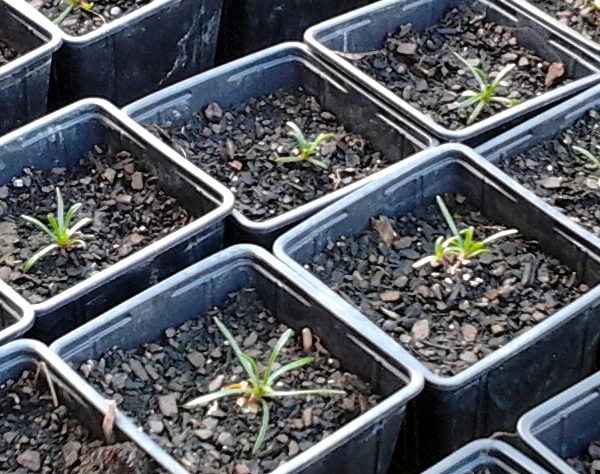

Armeria growing from seeds
- In the prepared soil, poured into shallow containers, sow seeds to a depth of two centimeters.
- Put containers in a warm, light place and wait for shoots. After the seedlings rise and they have two real leaves, they must be cut into separate pots or into a greenhouse and grown.
- Sowing seeds directly into the ground is possible in spring, but it does not give good germination even from prepared and treated seeds.
- The grown, matured seedlings can be planted in the personal plot as soon as the threat of spring frosts has passed. First you need to decide on a place in the garden where your perennial will grow. It should be with soil in which there is a lot of sand and stones. Warm and not shaded. Ideal - an alpine slide or a flower bed near a reservoir.
For reference: Armeria flowers don't like alkaline earth.... Planted in such soil, they get sick and lose their decorative effect. If your garden has limestone soil, you need to neutralize the lime by sprinkling with a vinegar solution. Or by adding ammonium nitrate to the soil, when preparing the site for planting.
Add organic matter to the soil a few days before planting... If you, as a landscape designer, decide that the Armeria will grow in a group and cover the ground with a carpet, you need to plant the plants in a checkerboard pattern with a step of 15-20 cm.To do this, you can divide the planting site with lines, and plant seedlings at their intersection. If the plants should stand out, they are planted one at a time at a distance of up to forty cm. When planting an armeria, the root neck must not be buried.at.Around the seedlings, you need to compact the soil and water them. For the next three weeks, it is necessary to remember about watering the "beginners", not allowing the soil to completely dry out.
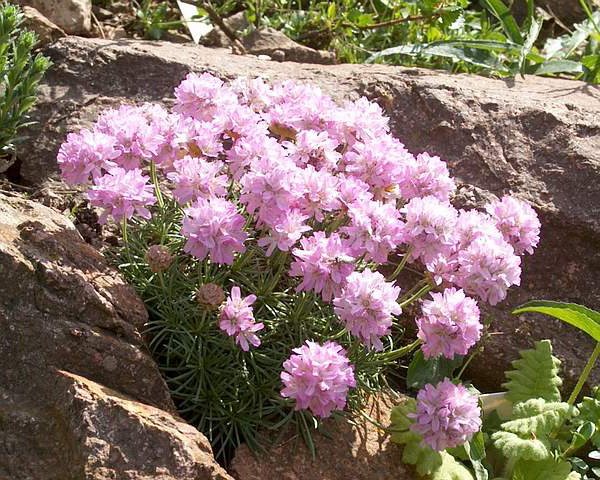

Armeria soddy Armeria juniperifolia photo of flowers
Planting by dividing the bush is performed in the springwhen young shoots begin to break through the ground. An old plant under the age of five is dug up and divided into several parts. Then the plants are planted in the holes. It is desirable to make the size of the holes larger than the diameter of the roots of the "beginner". This is necessary in order to spread well and spread the roots. It is imperative to tamp the earth and water the flower. In all the cases described above, it is advisable to mulch young plants. This will protect them from drying out and limit the growth of weeds, which are very inconvenient to choose from a dense leaf outlet of armeria. Plants obtained from seeds bloom, usually in the second year., and those that are part of an adult bush can bloom this summer.
Wintering Armeria
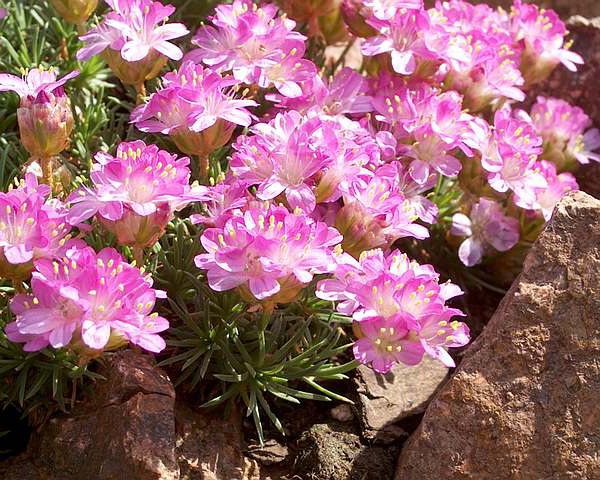

Armeria flower photo Armeria juniperifolia
It is worth focusing your attention on one more important issue. Namely: how does the Armeria winters? If the winter is snowy, then the plant can overwinter without shelter. It is necessary to cover only one variety - sod armeria. For covering material, you can take: spruce branches, ripe leaves, etc.
Both ordinary gardeners and experienced landscape designers for decorating rock gardens, rocky gardens, rabatok, flower borders have at their disposal a dozen types of armeria flower. Alpine armeria, beautiful armeria, seaside armeria, turfy armeria, common armeria, beautiful armeria, japanese armeria, Siberian armeria, armeria armeria and others. Even just reading the name of the species, I want to buy a flower and plant it in my garden.
Plant propagation
To create a beautiful carpet from armeria, seed propagation, as well as cuttings or dividing the bush, may be suitable.
Description of armeria
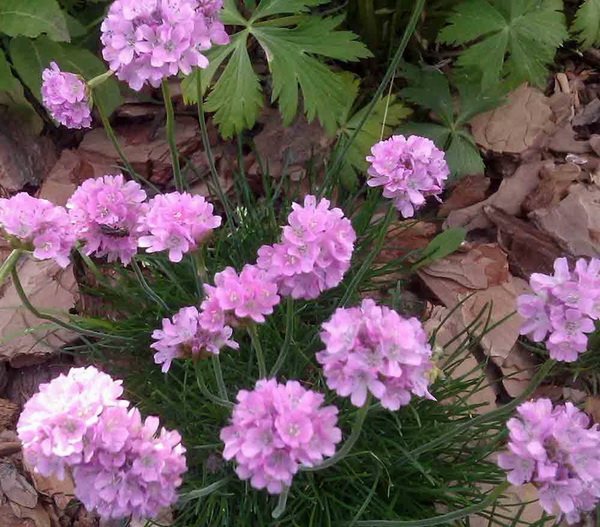

Armeria seaside landing and care armeria maritima photo
Armeria is a low perennial herb of the Pig family Plumbaginaceae, which forms thickets. Its height is 15-60 cm, depending on the species. The root is pivotal, short. Smooth erect stem. Sometimes it can be pubescent. The leaves that form the root rosette look like dark green grass. They are collected in dense curtains (pillows). Inflorescences are red, white, pink or purple. The flowers are small, connected in inflorescences in the form of a ball. The flower is photophilous, tolerates drought well. Blooms throughout the summer.
Pest control
In order for the Armeria flowers to please the gardener with bright colors, it is necessary to protect the plant from the action of pests. Although it is noted that the plant is quite resistant to disease if it grows under normal conditions on acidic soils. With insufficient acidity, aphids or spotting are possible.
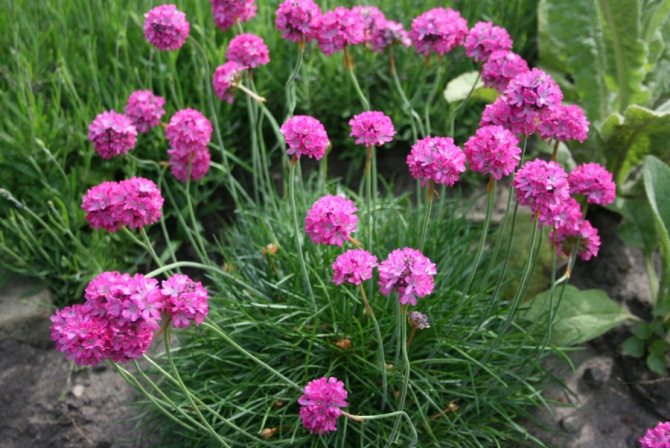

In advanced cases, pruning of infected shoots will be required. But for prevention and in the initial stages of aphid infestation, you can treat with insecticides, for example, "Intavir" or "Karbofos" will do.
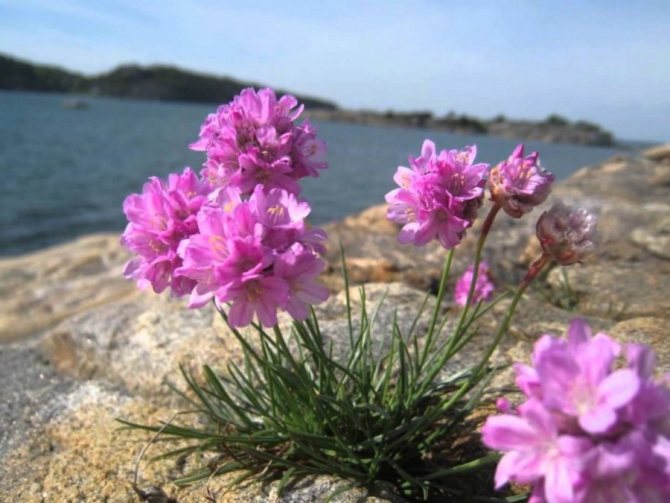

Root rot and spotting often affect the plant in conditions of frequent and prolonged flooding of areas. At an early stage, fungicide treatment will help.
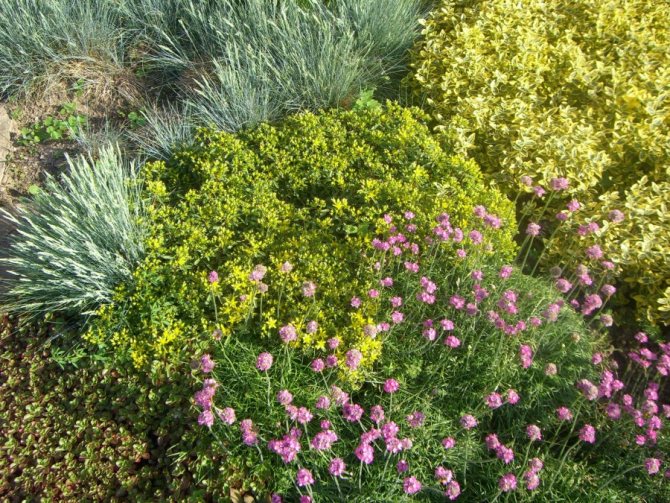

The dense and bright vegetation formed by the armeria can decorate a mixborder or a rabatka. The plant will look great in stone gardens or rock gardens.
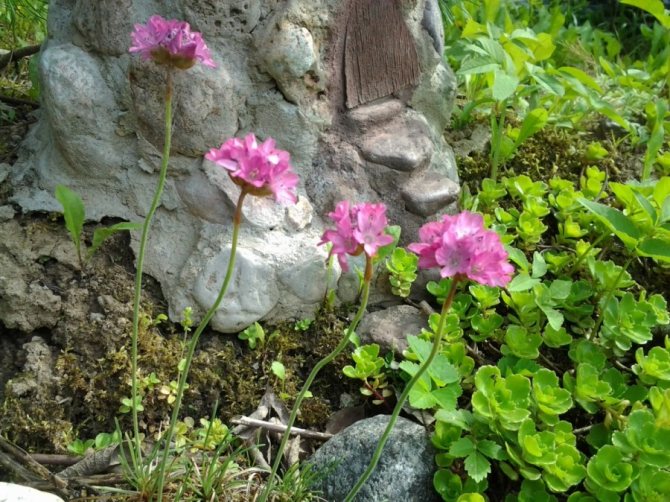

The year-round green carpet blooms with vibrant colors in summer. You can create a composition from different varieties of armeria or plant it together with a bell, thyme, saxifrage.
